#her dress looks so 1840s! but still Sleeves
Explore tagged Tumblr posts
Text

The Paris Élégant of 1838.
#i guess it can still be#Eighteen-Thirties Thursday#1830s#historical men's fashion#fashion history#fashion plate#romantic era#1838#her dress looks so 1840s! but still Sleeves#1830s man swan neck and snatched waist
93 notes
·
View notes
Text
History of weddings
What is a wedding?
A wedding is a ceremony where two people are united together in marriage. There can be many different forms of wedding traditions throughout different cultures. It is a prime function where 2 people can make promises to each other, usually done through vows. According to The Week, the idea of marriage is over 4,350 years old. The first recorded marriage took place in 2350 B.C. in Mesopotamia.
Wedding traditions over time
One tradition that has changed over time is not seeing each other until the ceremony. It was known that if you saw your future spouse before the ceremony it was considered bad luck, however now many couples participate in a private “first look” where they meet in private. Another tradition that has changed over time is the brides maids attire. Bridesmaids attire was considered to have been chosen by the bride and all had to be matching, whereas now many brides allow their bridesmaids to choose their own dresses sometimes in different colours or styles. Another tradition that has changed over time is the throwing rice at the newly weds. During the exit of the ceremony guests would throw rice over the newly weds to celebrate the marriage, whereas now things such as bubbles, petals and even confetti canons are used instead.
The evolution of wedding dresses
Over time bridal gowns/ wear has evolved over time. Starting with the 17th century the bride would be expected to wear her best gown no matter the colour. Leading onto 1840 where Queen Victoria was credited for starting the white wedding gown trend after she wore a white silk gown when marrying Prince Albert, dress makers then continued this trend. The white wedding gown really took off in the 19th century where embroidered silk, lace, and floral detailing were also popular. In the 19th century, it was also typical for bridesmaids to wear white dresses and veils. A victorian wedding dress was typically a very full body coverage with a high neck, full skirt, long sleeves and gloves. In 1915 brides would go for a simple gown without any extra ruffles or frills, but layers were still strongly in fashion. However here was a big shift in 1920s bridal fashion, as women started wearing sleeker, drop waist gowns. Long cathedral length veils were popular and balanced out the simple silhouettes. Head pieces such as floral crowns also began to evolve over this time period as well as shorter hemlines where dresses would end just below the knee. Brides in the early 1940s were married during the war , so their outfits typically donned formal pieces that they already owned as there was little money and material available for a wedding gown. Queen Elizabeth married Prince Philip after the war was over, however England was still on rations at the time. Her dress was an ivory silk and pearl embroidered scoop neck. Elizabeth Taylor's wedding dress in the film Father of the Bride had a huge influence on bridal trends. Sleek and simple were out, while full skirts, fitted bodices, and sweetheart necklines were in. At the start of the 1960s, shorter shoulder length veils became more popular. Three quarter length sleeves and structured fabrics, like crinoline, were also popular. Elizabeth Taylor's colorful wedding dresses, for her wedding to Richard Burton, started to popularize non-white bridal looks. The mini skirt also started to evolve in the 60s. In the 70s hair ribbons started to replace vails as well as non traditional dresses and people started to wear jumpsuits or matching outfits. Princess Diana's taffeta wedding dress inspired a lot of brides with the "more is more" approach to fashion, with her puffy sleeved and long trained dress. Off-the-shoulder wedding dresses gained popularity in the middle of the 1990s as well as Vera Wang opening her bridal boutique where she specialised in more spaghetti strap style dresses. By the mid 2000s strapless dresses were very popular and brides started adding simple embellishments like lace, to their gowns. By 2010 a strapless dress and a crystal belt was very popular! Kate Middleton made a case for the traditional when she married Prince William in 2011. Soon after their Westminster Abbey wedding, brides around the world started to replicate Kate's lace sleeves. All information for this was found on elle.com, “The Evolution of Bridal Style Through the Years” .

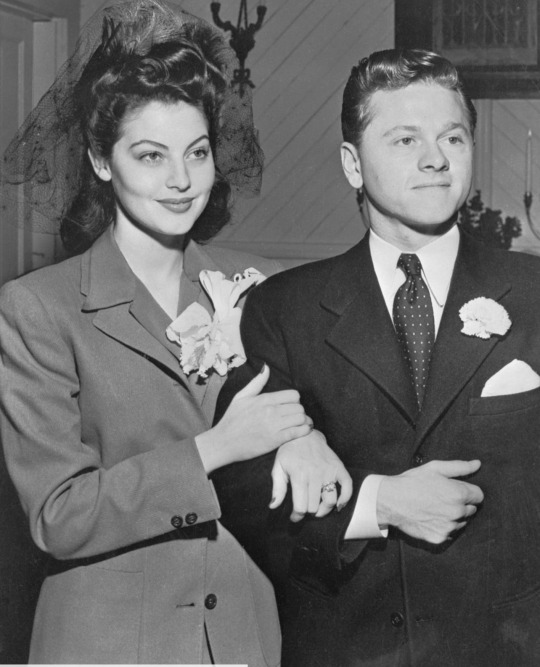

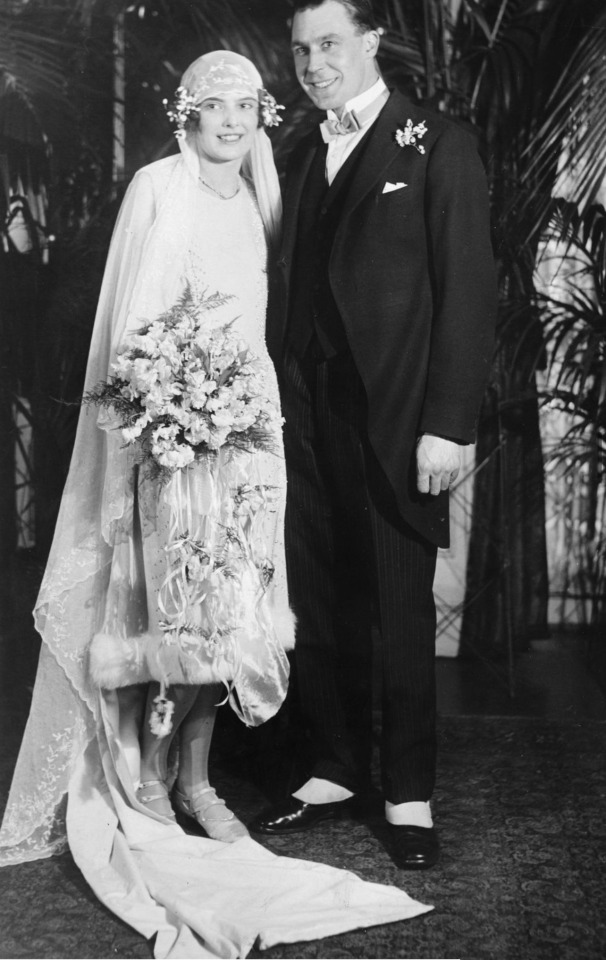


0 notes
Text
Okay so it is possible she is from the early 1840s because these elements do carry over but I think she looks more late 1830s. Either way though here's how I dated her

So the skirt shape is the biggest thing. This particular type of bell shaped skirt was popular from the 1830s into the 1850s when crinolines were invented and the skirt shape became much larger and somewhat rounder because they could. This type of skirt was instead supported by petticoats, particularly corded and sometimes horsehair petticoats that the more well off would have HEAVILY starched.
The low sleeve puff is something more particular to this late 1830s to early 1840s period. It's a remnant of the 1820s and early to mid 1830s large shoulder puffs, the volume just moved down.
The cuffs I don't have a particular explanation for, it's just a style I notice a lot on fashion plates and portraits in this period. You can see it throughout the 1830s which is part of why I place her in that period rather than the early 40s although you do still see some examples of it by that point
The curve of the bodice is something you start to see in the 1830s as necklines go more off the shoulder and while it definitely isn't something that alone could date a particular bodice it can give you a rough idea of the time
The cap is similar to the cuffs in that it's just a style you see frequently in the 1830s. The structure of this one is actually more akin to evening caps and likely this type of dress would have been worn with a bonnet which could have a cap underneath but since she's a moth lady obviously her headwear won't be exact for obvious reasons
Thank you for coming to my TED talk I just really wanted to infodump
Hang on one second if I don't tell everyone how to recognize the moth lady as being from the 1830s I'll explode
2 notes
·
View notes
Text
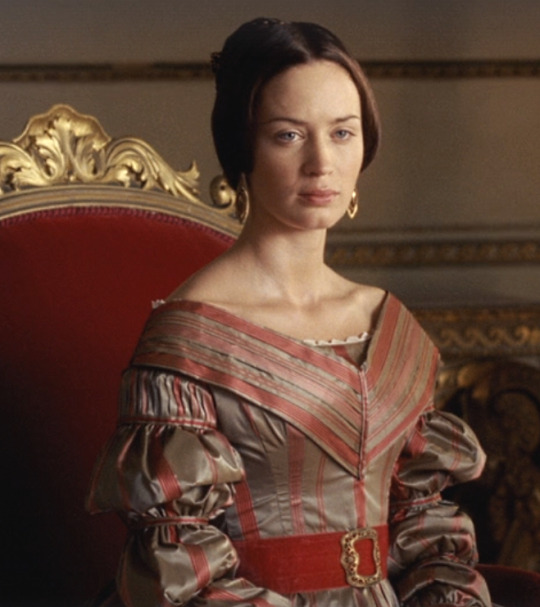
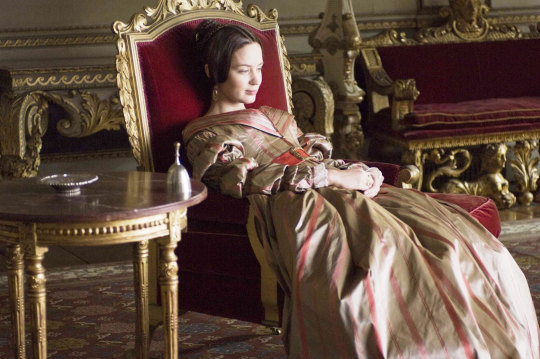
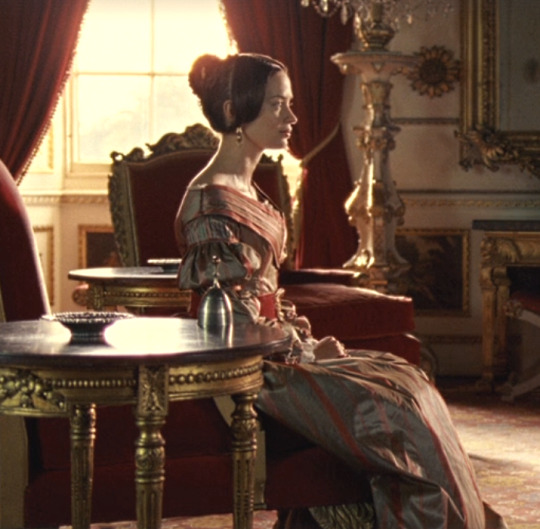
One Dress a Week Challenge
February: Brown
The Young Victoria / Emily Blunt as Queen Victoria
The colors in this dress make me think of a chocolate-covered cherry. This scene takes place very soon after her coronation, so it should still be 1837. The fancy 1830s sleeves are still in style, although her hairdo is starting to look distinctly "Victorian."
The V-shaped decoration across the shoulders makes me think of the orange-and-yellow striped dress from My Cousin Rachel (set in 1840), which is appropriate, as I gather that dress was reused for the Victoria TV series!
I notice the buckle on her waistband seems to be completely ornamental, as if they're trying to give the feel of a belt.
#one dress a day challenge#the young victoria#one dress a week challenge#brown dresses#emily blunt#movie costumes#period film#sandy powell#2009 movies#2009 films#victorian era#victorian fashion#victorian style#1830s#1830s fashion#queen victoria#19th century costumes#brown dress
98 notes
·
View notes
Note
The Ultimate Fashion History woman has a very ... twentieth-century understanding of sexuality. It's not, "you should be able to have as much or as little sex as you please, provided that your partner(s) are consenting adults", it's "SEX IS A PUBLIC GOOD, AND THERE SHOULD BE MORE OF IT!"
Also, UFH's report on the fashion of the 60's is also really bad. She doesn't really go into the Mod scene, the Laurel Canyon scene, or the sheer idealism of the designers at Haight-Ashbury (or even give their names!), it's just ZOMG I LOVE. Which is not the work of a good historian!
Yeah, the extreme subjectivity in an educational setting is one of my biggest issues with her. Like, yes, it's a YouTube video, so it would be fine to have some personal thoughts for entertainment's sake. But if you're still trying to teach people- and not just rating outfits for fun -constant interjections about how much you LOVE this style or LOATHE that one are unhelpful.
And the sex thing is...yes, exactly what you said. I saw this a lot in her 1860s video, where she demonstrated the layers of a woman's outfit by putting up a nude photo and saying, "here's a beautiful, sexy naked lady" and then commenting on how each layer made her look worse. She literally claimed, without irony, that feminine clothing in the 1860s was intended to desexualize the wearer.
(Interestingly, a claim I also read about 1840s undergarments in a truly asinine text from 1955. If your approach to dress history is identical to that used almost 70 years ago, you might want to rethink some things.)
The idea there being, of course, that wide, leg-concealing skirts and...long sleeves, I guess? are Unsexy and therefore Bad. Which is just. An astonishing thing to frame as objective truth.
#ask#anon#dress history#ultimate fashion history#the Sexy = Good And Empowered attitude reminds me of my mom too#she used to get on my case about not wanting to wear revealing or tight clothing#because 'you have a great figure and you're young! you should have fun with clothes!'#never mind that having fun doesn't mean the same thing for everyone#you see this a lot with people's attitudes towards the 1920s too. 'women were liberated by more revealing clothing!'#not by the OPTION to wear more revealing clothing. the revealing clothing ITSELF.#which is. very messed-up logic
95 notes
·
View notes
Text
Notes on Visions’ costumes
Kara (The Ninth Jedi): cannot for the life of me decide if Kara’s hoodie classify as a kimono. The shortened length puts it in Haori but it doesn’t have a straight collar. Also it’s serving more as a main piece instead of a jacket over the kimono. And the fact that it is properly closed with possibly a Hanhaba Obi if not something even simple with the lack of a visible knot. The sleeve length is common though sleeve hole is not small so I can’t put it in Kosode despite the straight slanted collar. So in the end it’s really more a hoodie jacket with overlapping collars and kimono sleeves? I did consider if I could call her whole ensemble a Jinbei but there’s the Obi and she is wearing it as a formal representation of herself. Yeah, so it’s more a kimono-inspired design but the sleeves, belt and Tasuki cord has all the most recognizable elements.
F (The Village Bride): Naturally all the kimono-wearing ladies has a modern/fantasy twist to it. Out of the bunch F’s ensemble might be closest to tradition, but it was still paired up with high heels instead of ankle boots. This point was particularly noted on during the special programme by director Hitoshi Haga as he mentioned the crew brought in heels to try the look on. Another deviation is that her single-layer collar is open quite wide over a turtle-neck, plus the sleeves are cut much shorter than the usual combo of furisode and the belt area is simplified. So you’d call her look 和洋折衷/Japanese-Western fusion (term applicable not only to fashion).
Haru (The Village Bride): The silhouette of Haru's bridal costume is closer to a 1840-50 evening dress with an off-shoulder neckline and poofy skirt. Though white only became western bridal standard after Queen Victoria's example, it has been a symbol of purity and choice of wear in rites of passage since the 15th century in Japan. The complementing blue recalls the craft of indigo-dyeing, under the spotlight courtesy of Tokyo 2020's designated colour. Despite a classic bridal/princess dress, Haru's horn headdress could be a smart subversion to the traditional Japanese bride's Tsunokakushi hat. 角隠し literally means "hiding the horns", as a metaphor to remind the bride to hide her temper and to become an obedient wife. It is the opposite case with Haru, where her love gave her courage to face the bandits.
Ocho (Lop and Ocho): I was a bit confused at Ocho’s childhood look at first because her ensemble is the standard festive costume for three-year-old girls at Shichi-go-san. I suppose it lends to the character’s innocence? The red-mustard-turquoise palette is a bit garish at first but the components from head-to-toe is actually quite typical: A (tsumami/fabric flower) kanzashi/hairpin, contrast lining or juban, hifu/poncho with the same hinata kamon/three-dots-in-a-circle family crest as her father and a pair of tabi/socks and funegata geta/wooden flip flops. Even the crest placement is faithful. Oh— the white chrysanthemum wouldn't be out of place if it was her mother that just died…
Ocho’s grown-up look is dramatic, over-the-top, perfect. The palette is the same except a darker shade in navy blue replaced turquoise. The gigantic bow reminds me, besides her namesake/kanji ‘butterfly’, of kabuki actors. I found the character Genkuro wearing a similarly exaggerated tasuki and side-slit kimono. While the character doesn’t share much in common, its play Yoshitsune Senbon Zakura, bears a similar backdrop of sakura blossom season and sibling rivalry. In kabuki makeup called kumadori, red is hero and blue is villain. In the mean time, scarlet eye makeup for geisha ‘wards off evil’ (along with the practical effect of making one look more spirited). I am fascinated by the conjecture that while Ocho’s costume is hinting at her antagonistic role, the dramatic blood eyeliner signifies Ocho’s mindset in seeing herself as the hero of the story. Then there’s the usual colour symbolism (or lack thereof) of stripping one’s identity with plain white armour/uniform. The cherry blossom + river motif is fairly normal. Before I noticed the Kabuki connection, I thought the side-high-slits were perhaps inspired by cheongsam and anyway is an act of rebellion against tradition by cutting up the furisode (thank goodness the sleeves are visibly longer than Kara’s). Either way, that’s a really cool look for a crime boss with the thigh-high boots and tattoo sleeves.
#yeah this for now#The Duel gets it own post. if.#star wars visions#The Ninth Jedi#The Village Bride#Lop and Ocho#my sw meta#sw visions#star wars
99 notes
·
View notes
Text
History of Chinese standing collars (part 1: Ming & Qing)
So, a lot of people nowadays refer to a certain type of standing collar as a “Mandarin collar” but I'm not sure if that’s legit, because standing collars throughout Chinese history looked different. I was confronted by this topic when I was writing my post on 1950s Chinese fashion and felt like I had to make a separate post. I’m gonna do a quick break down of all the different types of standing collars in historical Chinese fashion from the 16th century to the present and how they developed.
Ming Dynasty (1368-1644)
The first mature 立领 liling standing collars were applied to women’s robes in the late 15th/early 16th century. Before any garment with a standing collar was invented, both men and women in Ming China wore garments with either a 圆领 yuanling round collar, 直领 zhiling parallel collar or 交领 jiaoling crossover collar, with crossover collars being the more common in womenswear.

Source here
Early Ming Dynasty portrait of a lady in a crossover collar robe.
The development of a standing collar was in large part thanks to the invention/adoption of the 子母扣 zimukou metal clasp button. I wonder why the fabric knotted buttons used on round collar robes were not used on standing collars in this period? They were awfully similar to the pankous of later. Anyway, at one point in the 15th century, some women thought it would be cool to add zimukou to their clothes and it resulted in this (they were also used on 比甲 bijia, 半臂 banbi and 短衫 duanshan but those are irrelevant to collars):
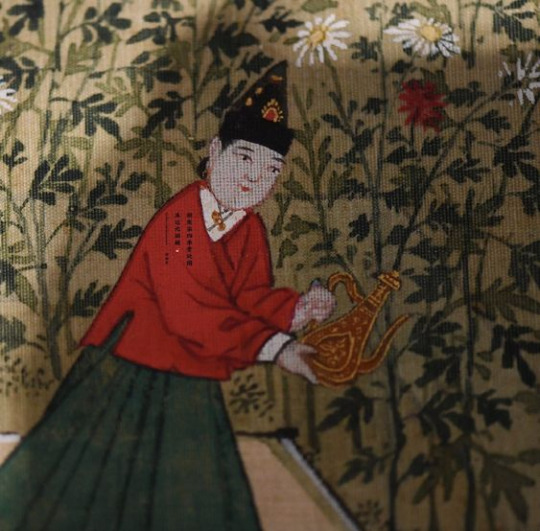
Source here
Part of 明宪宗元宵行乐图 (a painting depicting various Lantern Festival activities at the court of Emperor Xianzong), 1485. This lady is wearing a crossover collar robe with a zimukou at the middle.
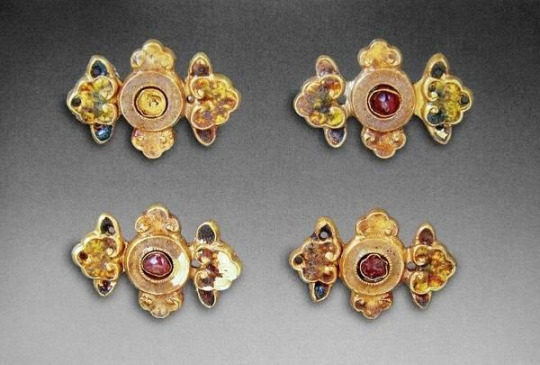
Source here
Modern reproduction zimukou. You could buy these for cheap on Taobao if you want to sew your own Ming style hanfu btw.
In the 16th century a fashion revolution took place in China: the standing collar, which came out of nowhere, began to suddenly dominate women’s clothing. This OG Chinese standing collar was very tall and form fitting, usually covering all of the wearer’s neck. It had sharp, rectangular edges and was closed by two zimukou, one placed at the bottom of the collar where it meets the bodice and another slightly above, not reaching the top of the collar. An important feature that set this apart from the collars of the 20th century is that it was unstiffened and made of the same fabric as the robe, meaning it was soft and could be worn with the top bit folded over, showing the lining which could be of a contrasting color. For archival purposes let’s call this collar style 1.
There are various theories as to why the standing collar was invented, e.g. because of colder climate during the little ice age, which peaked in the late 16th/early 17th century. Methinks it was just a fad which stayed.
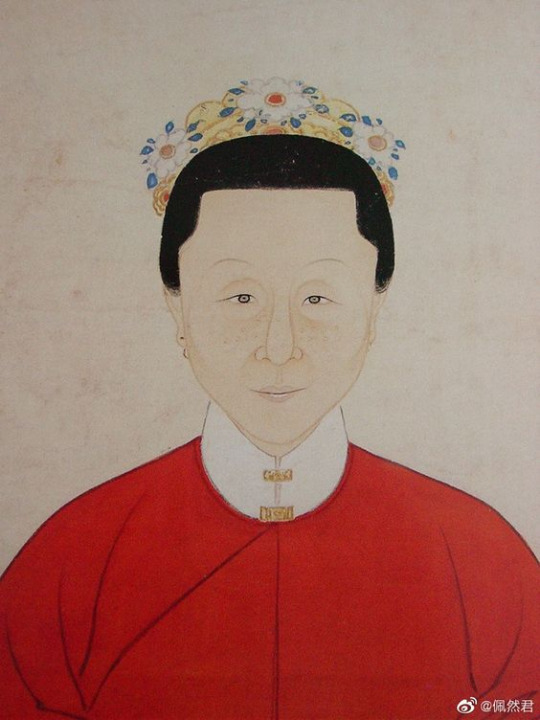
Source here
Late Ming Dynasty portrait, collar style 1.
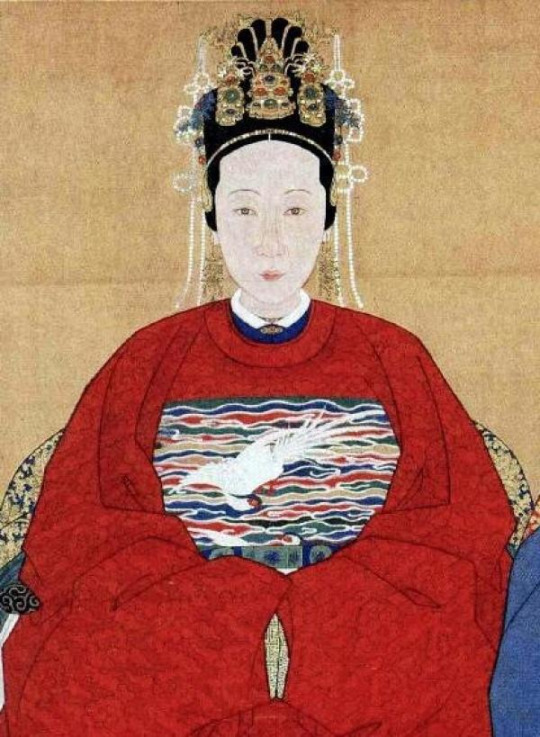
Source here
Late 16th century/early 17th century aristocratic lady wearing a standing collar robe underneath a round collar robe. The top of her collar is folded over. Collar style 1 variation 2.
Qing Dynasty (1644-1911)
This style of collar became the norm for Han Chinese women’s fashion in the mid to late 16th century and stayed that way throughout the 17th and 18th centuries. While the clothing silhouettes and accessories changed, the shape of the standing collar remained the same.

Source here
Late 17th century illustration for pornographic novel 肉蒲团 (1657). Collar style 1, but it became fashionable in the 17th century to have rows of piping around the neck for each button, so variation 3. Oh and wlw pride come throoouuuugh
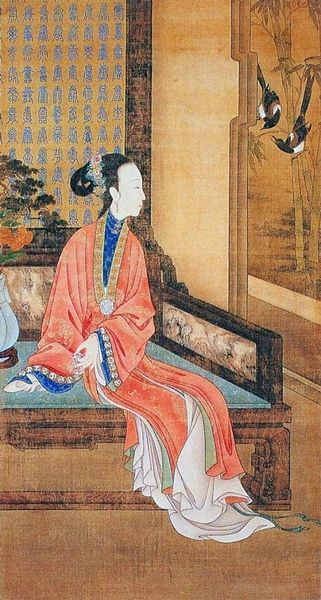
Source here
Early 18th century court painting, collar style 1 variation 3.
At some point in the late 18th century Han women decided it would be cool to use 盘扣 pankou, this fabric braided/knotted button of Manchu origin (more on Manchu dress later) on their collars instead of zimukou. The decoration also became more extravagant, with often rows of thick binding, piping or trim, corresponding to the decorations on the rest of the robe. It’s also slightly shorter, the upper button being at the very top of the collar. Let’s call this collar style 2.

Source here
(Presumably) late 18th century reverse glass painting showing collar style 2. The late 18th century deserves more attention, it’s such an important transitional period but also charming in its own way. This is true of European fashion of the period as well, I honestly love both places in the late 18th century.
In the beginning of the 19th century, the fashionable collar shape suddenly changed for some reason. It became extremely low, approximately only 1-2cm tall, only tall enough to accommodate one button. It still had crisp, rectangular edges. You could say this is another variation of collar style 2 but it is so iconic to the 19th century I think I’ll call this collar style 3.

Source here
Reverse glass painting ca. 1830. Han lady wearing a robe with collar style 3.
Now a brief look at Manchu womenswear. I am not an expert on Manchu historical fashion so tell me if I’m wrong. So the Manchus, who were apparently a confederation of Jurchen tribes from the area in what is northeastern China nowadays, invaded China successfully in the 1640s and remained the rulers of China until 1911 when they were replaced by the Republic of China. Throughout most of the Qing Dynasty Manchu women wore collarless robes, it was not until the mid 19th century that some Manchu women started to wear detachable collars to emulate Han women’s fashion, and not until around 1908 (!) when standing collars were actually added to their gowns themselves. Yes, period dramas did Manchu women dirty, poor gals have been dressed in the wrong costumes this, entire, time. The misrepresentation of Manchu historical fashion in the media in general is just fucking infuriating, but well, topic for a future post.

Source here
Late 17th century/early 18th century portrait of a Manchu lady. She is wearing a 衬衣 chenyi, a robe with straight sleeves, no slits and closed at the right side. It’s a casual gown worn for everyday activities. Her chenyi is collarless and the collar is closed by binding.
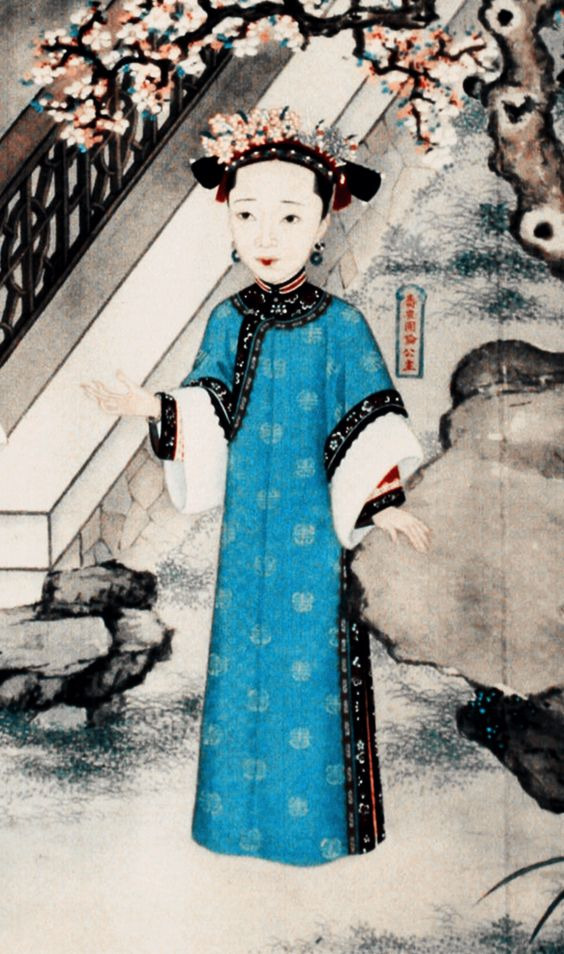
Source here
1840s/1850s court gown. She is wearing 氅衣 changyi (the bottom part of the first character should be 衣 not 毛 but this character is so obscure that it literally DOES NOT EXIST in the Chinese language anymore omg), a more elaborate style developed in the early 19th century with slits down both sides and wide trims along the collar, cuffs, side closure, side slits and hem. I have yet to see an extant example with a standing collar, all the changyi from the 19th century I’ve seen in museum collections are collarless, so the collar seen in paintings must’ve been detachable. Maybe some Manchu women liked Han women’s fashion and wanted to wear a detachable collar. I have, however, seen Manchu women’s vests and jackets with standing collars. These were similar to late 18th century Han women’s collars, so collar style 2.
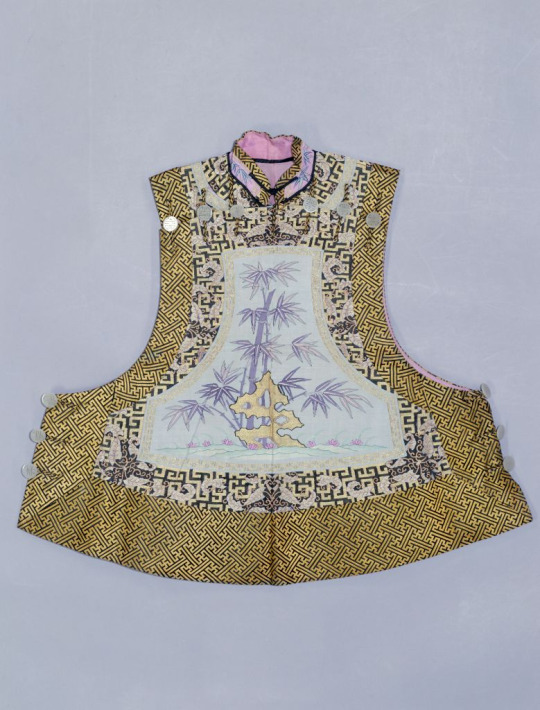
Source here
1890s/1900s women’s vest with collar style 2.
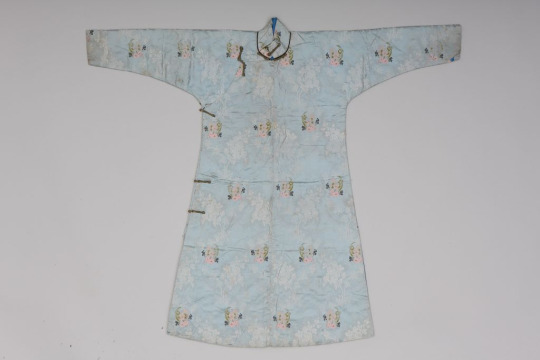
Source here
Ca. 1908. Chenyi with standing collar. If the passage of time is still not clear, notice the Western fabric used. Collar style 2.
At first glance this might look like a cheongsam but it is not. Chenyi did not have slits down the sides, unlike most 20th century cheongsam. It may have been a source of inspiration for cheongsam though, as I have explained in one of my 1930s posts, although the more obvious prototype for cheongsam was the changyi with slits and standing collars.
Let us now turn our attention to Manchu menswear, which is where things get complicated. In the 17th and 18th centuries, the Manchu riding habit, 行服袍 xingfupao, was a form fitting calf length robe with form fitting long sleeves and 马蹄袖 matixiu “horse hoof cuffs”, closed at the side with pankou. It was constructed in the same method as Han Chinese clothing. This original Manchu robe was collarless----I cannot stress this enough. The Manchus did not come barging into China wearing robes with standing collars goddamnit, get your facts right period dramas.

Source here
Portrait of Emperor Kangxi in a xingfupao. This is from the early 18th century already but the style didn’t change much so you get the idea. I love this color btw I think he looks great in it.
The xingfupao was an informal riding habit and only one small part in the gigantic system of Manchu court dress, the rules of which are well documented but I don’t bother to look them up. If you would like to do that, Google 大清会典. At one point in the early 18th century some Manchu dudes decided it was cool to add a collar to their xingfupao (like... Han women??) and it resulted in this:

Source here
An early example from the Kangxi era (1661-1722), a xingfupao with a standing collar of a contrasting color. The hem is detachable for horse riding (horse riding was an important aspect of Manchu culture and that influenced many of their fashion decisions). Judging by the fur lining I assume the standing collar was added for warmth in winter? I also saw some xingfupao with fur trim attached to standing collars so maybe that was the purpose.
Standing collars on xingfupao was constructed in a similar way to Han women’s collars, with rectangular edges and closed by two buttons. Pankous, which were unique to Manchu dress, were used instead of the Han zimukou. It appears that this collar was also soft and unstiffened, so it could be worn with the top bit folded over like in ye olde times (the 16th century). It’s important to note that xingfupao with a standing collar were not common at all, maybe a 1/20 probability to see in museum collections. Construction wise it’s similar to collar style 2 but it appeared earlier and was exclusive to menswear, so let’s call it collar style 4.

Source here
Qianlong era (1735-1796) portrait, xingfupao with standing collar of the same color folded over. Collar style 4 variation 2.
Another garment with a standing collar was the dress of the officials, known by white people as “Mandarins”. From the artworks and photographs I’ve seen, the collar only appeared in the outfit with a 行服褂 xingfugua, a button down tunic with straight, wide sleeves and slits at the front, back and sides. It was usually worn in combination with xingfupao, like how a shirt and vest are fixed combinations in European menswear. However, the collar of this kind of outfit was separate from the tunic itself. A plastron with an attached collar was worn underneath the robe and tunic (completely detachable collars were also used I think??) and the collar was buttoned from the inside. Not sure if this qualifies as a standing collar at all since it isn’t even attached to the robe itself, but anyway let’s just call this collar style 5.
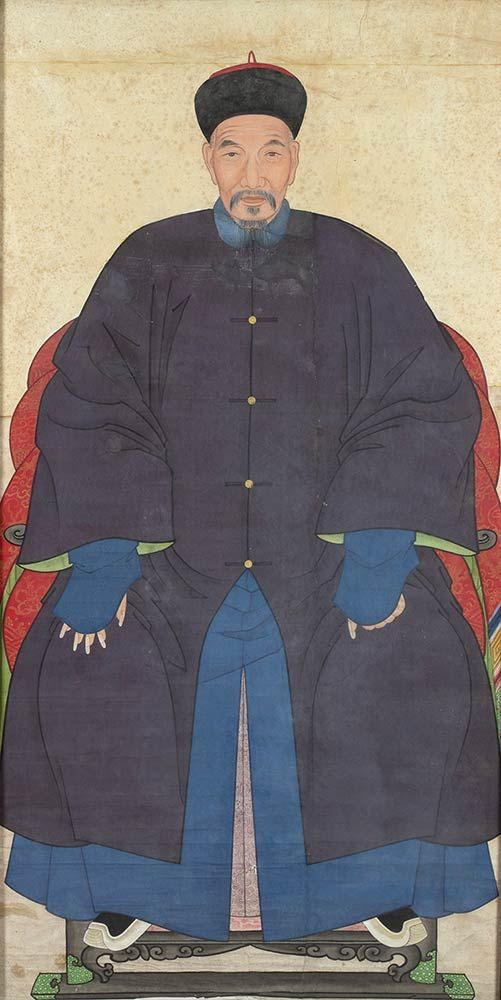
Source here
19th century portrait of an official. He is wearing a blue xingfupao, an indigo xingfugua and a blue detachable collar; a standard ensemble (well he’s also wearing pants and boots and stuff but that’s not the focus here). Collar style 5.
Oh I forgot to mention, after the Manchus took over China, they enforced their dress code on Han Chinese men but not Han Chinese women, so in the Qing Dynasty Han and Manchu menswear were one and the same but Han and Manchu womenswear were not.
I’ve only been talking about court dress so far, educated/well off civilian Han men would wear 长衫 changshan, a floor length robe, sometimes with a 马褂 magua, a short riding vest (derived from xingfugua), whereas poorer Han men would wear 短打 duanda, a short button down shirt, and pants. Well people who wore changshan also wore pants underneath but they’re not visible. All men wore pants tbh (incoming tangent), a while back when Harry Styles in a dress (which I stan) was making the rounds on social media some well meaning people were trying to find historical precedents for men wearing dresses and they named Chinese historical clothing as an example. I just wanna say, while I appreciate the sentiment, the harsh reality was that historical Han Chinese fashion was extremely gendered (except for a few brief time periods and a few select garments). Pants were reserved for men and skirts for women, the long gown like garments seen on men in historical portraiture were all robes, not dresses; you wouldn’t consider a long coat or bathrobe a dress nowadays, would you? Men always wore pants as undergarments while women wore petticoats. However I think that’s great for illustrating how our perception of whether a garment is masculine/feminine could change over time and that gender is socially constructed. Back to the main topic, to my knowledge, magua never had collars because it was a vest, changshan commonly had collars and duanda sometimes did too. I’m not sure when the standing collar began to appear on changshan, maybe when the court xingfupao gained collar style 4 it stuck in civilian fashion, maybe it was some point in the 19th century.
Anyway, fast forward to the late 19th century, the men’s changshan had a tall standing collar but again it was different to everything we’ve seen so far. It was exceptionally tall and had a smoothly tapering edge closed by only one pankou at the bottom. This resulted in a huge v shape gap down the middle. It’s still unstiffened but because of the lack of a rectangular edge it couldn’t be worn folded over. Let’s call this collar style 6.

Source here
Late 19th century/early 20th century portrait of a man. Changshan with collar style 6.
Let’s finish this part with Han women’s collars in the 1890s and 1900s. Around this time Han womenswear began to modernize and become simpler, but that trend did not apply to collars: the collars of Han women’s robes suddenly became unnaturally tall. They were so tall that they touched the wearer’s cheeks and couldn’t be closed at the front at all, kind of resembling Regency era European men’s collars?? This style of collar was oftentimes called 元宝领 yuanbaoling, ingot collar, or 马鞍领 ma’anling, saddle collar, after the object it resembles. Let’s call all of these tall collars that touch the wearer’s face collar style 7, but bear in mind these had a lot of variations.

Source here
Photograph from the 1900s. This could be categorized as a cursed variation of collar style 6 judging from how it only has one pankou and a tapering edge instead of a rectangular edge. But like, belle époque Chinese collars are a whole other species, so let’s comfortably call it collar style 7.

Source here
More collar style 7 representation. This collar style will never stop being funny to me, like just look at it it’s so tall.
So, in summary:
Collar style 1: OG Ming Dynasty standing collar, in fashion from the 16th to mid 18th century. Tall, unstiffened, rectangular edges. Closed with two zimukou. Could have piping (17th & early 18th century). Could be worn with top bit folded over (16th & early 17th century). Worn by Han women.
Collar style 2: developed from collar style 1, popularized in the late 18th century. Medium height, unstiffened, rectangular edges. Closed with two pankou/other fabric buttons. Commonly has binding, piping or trim. Worn by Han women in the late 18th century, partially adopted by Manchu women in the late 19th century.
Collar style 3: developed from collar style 2, exclusive to the 19th century. Extremely short, unstiffened, rectangular edges. Closed with one pankou. Commonly has binding, piping or trim. Worn by Han women.
Collar style 4: collar style 2 but simpler, appeared in the late 17th/early 18th century. Tall, unstiffened, rectangular edges. Closed with two pankou. Commonly plain. Worn by Manchu & Han men.
Collar style 5: detachable standing collar, a staple of official’s uniforms throughout the Qing Dynasty. Medium height, unstiffened, rectangular/rounded edges. Buttoned from the inside. Always plain. Worn by all officials (exclusively men in this era).
Collar style 6: civilian men’s collar characterized by v shape gap at the front, I don’t know when it first appeared, some point in the Qing Dynasty. Tall, unstiffened, rounded and dramatically tapering edges. Closed by one pankou. Worn by civilian Manchu & Han men.
Collar style 7: cursed belle époque (1890s & 1900s) women’s collars that touched the wearer’s face. Extremely tall, stiffened, both rounded and rectangular edges existed. Closed by one pankou at the bottom but sometimes had more pankou for ornamental purposes. Worn by Han women in this period.
Join me next time as we dive into the Republican era where things get extra complicated.
#hanfu#historic fashion#chinese fashion#chinese history#ming dynasty#qing dynasty#16th century#17th century#18th century#19th century
350 notes
·
View notes
Photo

Day 9: Historical
Y’know, I’ve kinda started giving up on catching up, so I’m half-considering just doing one a day still even if it is a few days late.
There was no way I was gonna get through this challenge without flexing the history student/historical fashion enthusiast side of me, so I was very excited for this prompt. I’ve always low-key wanted to try drawing some AC characters as historically accurate as I could, but that would take a lot of research and time that I wasn’t up for doing just yet, so I decided to do something easy and just convert one of the more historically accurate outfits in the series to something a bit closer for the time period, and I picked Evie’s ballgown from AC: Syndicate, which takes place in 1868.
If you want a full explanation of my design process, it’ll be below the cut! 👇 (fair warning, it’s a little long)
DO NOT USE, TRACE, RE-COLOUR, COPY, OR RE-POST WITHOUT PERMISSION Reblogs are appreciated ❤
Bit of a disclaimer first: This is in no way to shame the creators and designers of AC. They’ve created some seriously awesome designs, accuracy be damned. And I understand sometimes you gotta sacrifice accuracy for aesthetic and character personalities and there’s nothing wrong with that. And while I do think I have a pretty good grasp on historical fashion, I’m no expert, of course. This is purely just for fun. 😁
Soooo, in my opinion, this outfit is one of the more historically accurate outfits in the games. Here’s a link to the original dress for reference [link]. Which is kinda weird since it’s a remodeled version of Élise’s dress from Unity (Late 1780s-90s) and it’s actually less accurate in that game, but that’s a whole other story. AC Syndicate takes place in 1868, so I based my design off of dresses from that decade.
Overall, the silhouette isn’t too far off. Day dresses still had full sleeves and high collars, but the off-the-shoulder collar and short puff sleeves were standard for evening dresses of the time. But they are a bit...plain in the OG dress. Most dresses, especially evening gowns, tended to have more decoration and frills around the collar, as that coupled with the wide skirt gave the illusion of a smaller waist. I heavily based the collar off of [this dress] from 1864. I thought it translated well from the sweetheart neckline the OG dress has that isn’t really period-accurate. I kept the bodice largely the same, aside from moving around seams and shortening it, as the waistline is a bit too low on the OG dress.
The skirt shape however, is a bit outdated. The “bell” shape the OG dress has is more fitting for the 1840s or 1850s. The 1860s had a very distinct skirt shape as it was the transition period from full, round skirts to the narrow skirts with a bustle at the back. In the 1860s, crinolines and skirts were more of an “elliptical” shape than round, especially towards the latter half of the decade. Examples: [link], [link] So, I made her skirt a bit wider and fuller at the back. I also ditched the split skirt. While I did see some examples with a split skirt, it doesn’t seem overly common. And while I did want to keep as close to the OG dress as possible, I also didn’t want it to look out of place for the time period, so I went with an overskirt, a style seen in several contemporary fashion plates: [link] (1862), [link] (1865) I mostly picked different features from those examples to make a design that was similar to the OG dress.
As for minor accessories, her hairstyle is kept largely the same. The hairstyle she wears with the OG dress and throughout the game is...actually pretty accurate. It is almost identical to [this style] from 1862, with the only differences being that Evie’s is a bit more wild and her ears are uncovered (that being said, I couldn’t resist still leaving some loose strands, it is Evie after all). I also gave her a flower headdress, which can be seen in several of the sources linked above. Flowers were very common as decoration on dresses and in hair throughout the century. Of course, not everyone has access to fresh flowers, and it tended to be easier just to use fake ones made from fabric, like this example here: [link] I also gave her gloves. She didn’t wear any in-game, but historically speaking she most certainly would have. Shorter gloves seem more popular and can be seen in many sources linked above, so I based them on those. Her necklace I left untouched due to its significance.
And uhh...yeah, I think that’s it. If you read through all that, than props to you and thank you! I hope you enjoyed my ramblings. I did also try to keep the colours all in similar places as the OG dress so the overall palette is the same. Hopefully it’s still fairly recognizable.
#assassin's creed#codextober#ac syndicate#evie frye#assassin's creed syndicate#ac#historical fashion#19th century#victorian era#1860s#artists on tumblr#ac art#my art
102 notes
·
View notes
Text







Entry 2 in my historical Disney series: Cinderella, set in late 1860s/early 1870s France!
This one was a lot easier than Snow White due to the large amount of extant (surviving) gowns and fashion plates available, whereas for Snow I only had artwork to rely on. For a while, though, although setting Disney's take on Cinderella in France was a no-brainer (given that the Cinderella story as we all know it originated from France, Cinderella's house is constantly referred to as a chateau, and Tremaine is a very French-y surname) I was tossing myself between the 1860s and 1880s in deciding where to set Cinderella time period-wise. I decided quickly enough that it takes place in the 19th century but the movie showcases a mishmash of different eras - Anastasia and Drizella appear to be wearing late Victorian era bustles under their dresses, Lady Tremaine's outfit screams 1890s with its narrow silhouette, high neck, and large leg-o-mutton sleeves. However, upon digging a little deeper into the movie, I found that most of the dresses worn by the female characters and background women at the ball - including Cinderella's ball gown - have more of an elliptical shape in the skirt than a wide, circular shape achieved by the crinoline. Furthermore, narrower silhouettes, made possible by the crinolette - the transition foundation between the crinoline and the bustle - emerged in the mid to late 1860s, so I thought that using fashions from between 1866 to 1872 - right before dresses started getting even narrower - was ideal for this princess.
Cindy's everyday work clothes are inspired by photographs of working women from the mid-Victorian era, mainly these two . I wasn't afraid to use references from a little earlier than my target area, as it would make since for this outfit to be some of the stepsisters' castoffs. I made it a blouse-and-skirt combo because 1.0 this totally existed during the Victorian era and 2.) I didn't want to make it entirely brown or saturated blue because I have always liked how the blue sleeves compliment the brown dress in the original design. I also redesigned Cindy's hair because, as much as I love her 1940s-50s bumper bangs, they definitely would not fit in this area. And HER HAIR IS STRAWBERRY BLONDE, NOT LEMON YELLOW.
For her mother's pink dress, I considered that the base of the dress should be that of a dress from the late 1840s or 1850s, given that it belonged to Cindy's mother and she died when Cindy was still a child, so it must have belonged to this era. However, the slightly off-the-shoulder bertha and pointed waistline seemed to have been still fashionable during my target era of research. I'm also not sure when Cindy got her sewing book, but I feel it would be slightly out of date too. I wanted to remain true to the homemade, over-the-top feel of the original design, but I have a feeling that the mice may have secretly gotten inspiration from the stepfamily's wardrobe, and it's likely that they had some fashion magazines, such as La Mode Parisienne, lying around. Some of the extant gowns I was inspired by included this, this, and this.
For Cindy's magical silver/super pale blue (BUT DEFINITELY NOT MEDIUM BLUE) ball gown, I was super excited about putting a late 1860s/early 1870s spin on this look - given that I've seen it redesigned once or twice in the 1880s style, and way more times in the 1860s style with a crinoline. I wanted to maintain the "something simple, but daring too" look of the original design, so while I wanted this to be a stunning, ethereal ball gown, I didn't want to make it too outrageous. I based my design heavily on this portrait from the late 1860s - as seen in the hip things (present in the original design!!), the flowers in the center of the bertha, and my sad attempt at a lace overskirt with my white gel pen. I also decided to make back drapes on the skirt that were inspired by Christine's masquerade ball gown in the 2004 POTO movie (which is supposed to be set in 1870). Her hairstyle is an updo that was fashionable during the late 1860s/early 1870s and can be seen in a ton of photographs and fashion illustrations. I was also hugely inspired by this photograph, not just because of the overall look of the gown, but due to the fact that the lady is wearing a black velvet choker just like Cindy! It's hard to tell whether the ornaments in her hair are little flowers or star-shaped, jewel-encrusted barrettes a-la the Empress Sisi, but I went with the latter for this purpose. And, of course, I had to show off the glass slippers! So I included a close-up of my design - a rather simple shoe that I modeled after the shape of a pair of slippers from the late 1860s.
Finally, for Cindy's wedding gown, I'm unsure if it's what a royal bride would have worn around the early 1870s, as I found little to nothing about that, but I did my best. I aimed for a simple yet elegant look with the wedding dress too, as it was in the film. It is essentially a combination of this dress, as seen in a fashion plate from 1868, which I stan because of the "floral" trim, and this dress from an 1870 plate. I took inspiration from this photograph for the veil and bouquet and this plate for the hairstyle.
Yes, I know I didn't give Cindy a consistent face. Forgive me.
Commissions info
62 notes
·
View notes
Text
Daughters of Arendelle - Chapter 47
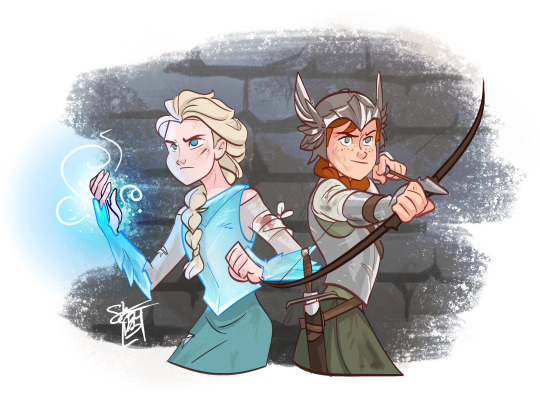
Author’s Note - Hello everyone, I know it’s been forever since I last updated this story. I really have been working on it. Here’s Chapter 47, yes there will be more.
*******
CHAPTER 47
September 16, 1840
Sweat dampened the fresh bandage encircling Anna’s forehead. Sitting on the edge of the bed, her eyes closed against a wave of nausea. Dull pain throbbed through the wound in her thigh with each heartbeat.
The soft, warm bed beneath her beckoned with a tempting siren call. No, not till I’ve seen Elsa. Her back stiffened with resolve, sending a jolt of pain through bruised ribs, stealing her breath away.
“Anna, are you okay?” Wooden fingers gently touched her arm.
“I’m fine, Olaf.” She managed a weak smile.
“Oh, that’s good.” The snowman chuckled. “because you look really bad.”
“Olaf!” Alma turned from the dresser to glare at him.
“What?” A hand flew to his mouth. “Oh, I’m sorry.” He leaned in close with a loud whisper. “I thought you knew.”
Anna chuckled, it ended in a sharp gasp. Pressing a hand against the muscle twitching along her ribs, she managed a weak smile. “It’s okay, Olaf. I know I look a little rough.”
“It’s more than a little.” He happily informed her.
She flinched, there were times when the little snowman’s charming honesty could be brutal. Tough love aside, she’d been relieved to find him at her bedside when she woke. If he’s here that means Elsa’s still alive. Startled by the thought, she pushed it away with a shudder. Of course, Elsa’s alive. But for how long? Whispered the dark voice that had plagued her nightmares.
Shut up! Muscles tightened along her jaw, straining to hold against a threat of tears.
Haunting dreams of a bloody and bruised Elsa standing at her bedside had taken a toll. Sometimes she vanished when Anna reached a shaking hand towards her, other times, she collapsed across the bed, succumbing to her wounds. Always there was that haunting fatigue in her eyes, just as there had been the night of the battle. I should have made her stay with me.
“Let’s get your slippers on, Princess.” Not waiting for a reply, Alma knelt before her.
Pulled from dark thoughts, Anna didn’t argue. Watching the handmaiden work the slipper onto her bare foot, was another reminder of how weak she’d become. Her usual morning routine had turned into a series of embarrassing moments.
Alma had to help her with the most basic tasks. Even with help, they had taken far longer than normal to complete. Alma’s insistence on changing her bandages before helping her into a fresh nightgown, had dragged the process out even further.
No amount of protest or pleading would sway the handmaiden from her task. Bandages and fresh nightgowns could wait, she just wanted to see her sister, and Kristoff.
Kristoff, she could almost feel the warmth of his strong arms curling around her. After all of this, I wouldn’t blame him if he ran back to the mountains and never returned. Icy fear tickled her spine.
“Anna?" Olaf said. “Are you cold?”
“What?”
“You shivered.”
“No, I…I’m just worried about Elsa,”
“Yeah, me too. I wish she’d wake up.” His shoulders slumped with the confession.
“Hey, she’s going to be alright.” It was a gentle lie, as much for her own sake as his. Slipping an arm around him, she’d meant to pull him into a hug. Cold bit into her hand and through the thin fabric of the nightgown. Jerking away, she rubbed at the palm, half expecting to see snowflakes forming beneath the skin. She tried to shake off the thought. Elsa’s magic won’t hurt me. Still a faint voice whispered, again. Enough!
“Where’s Kai?” There was a bit more bite in the question than she had intended. “He should have been here by now.”
Alma didn’t look up as she finished with the first slipper. “I’m sure he’ll be here shortly, ma’am. He knows how eager you are to see Her Majesty.” She reached for Anna’s uncovered foot.
“If he’s not here soon I’m going to…” White hot pain shot through her leg, tearing a strangled cry from her throat. She clutched at the bedsheets with one hand, the other came to rest on Alma’s shoulder, twisting the fabric of her jacket.
“Anna!” Olaf caught her arm, trying to steady her.
“I’m sorry!” Alma lowered the half-covered foot. “I’m so sorry, dear.”
“It…it’s alright.” Panting through the pain, Anna closed her eyes against a wave of nausea. Muscles quivered along her ribs. Pressing a hand against them, she flinched at the pain. None of the fairy tales, from her childhood, ever spoke of the hero having to recover from battle wounds. You’d think at least one of them would have mentioned how painful stab wounds are, or how sore you’d be after a battle. Her shoulders dropped with a weary sigh. They lied about handsome princes, why should I trust the rest?
Gloved fingers touched her cheek.
“Are you alright, dear?”
“Stop asking me that!” Even as the handmaiden, shrank back, Anna couldn’t stop herself. “No! I’m not alright! I ache all over, and it hurts to breathe!” Sucking in a breath, tears filled her eyes. The outburst drained and embarrassed her. Unable to meet Alma’s gaze, she stared at the floor. “I…I’m sorry. I didn’t mean to yell.”
Olaf touched her arm, she drew away.
“Anna,” The gloved hand cupped her cheek.
Not trusting her emotions, Anna closed her eyes.
“It’s alright, dear. I know you’re tired and hurting. It’s been a trying time for all of us. We’re all a bit on edge. Let’s finish getting you dressed, so you’ll be ready when Kai gets here.” Not waiting for a reply, she knelt and began gently working the slipper on Anna’s foot.
Biting at a trembling lip, Anna watched her work. She didn’t deserve that.
With the slippers securely in place, Alma rose, brushing her hands against her skirt. “Why don’t we get your robe on? It’s a bit chilly in the hallway this morning.”
“Okay.” Came the soft reply.
Alma hurried across the room to retrieve the garment. A moment later she was at Anna’s side holding the robe open for her.
Gritting her teeth, Anna raised an arm.
Alma slipped the sleeve over it.
Anna swiped at the other sleeve, missing on the first try. Mumbling under her breath, she tried to ignore the bead of sweat trickling down her cheek.
“Let me help.” Olaf guided her arm into the opening.
She eased her arm through the sleeve, biting her lip against the pain. Once her hand snaked through the end, she let out a heavy sigh. “Thanks, Olaf.”
Alma pulled the robe up onto her shoulders, adjusting it. “There we go. You’re all set.”
Overcome with a need to hold someone, Anna grabbed Alma’s jacket, pulling the startled woman into an embrace. “I’m sorry, Alma. I didn’t mean to yell at you.”
Arms wrapped around her, in a light, but loving embrace. “It’s alright, dear.” Gentle pats tapped against her back. “It’s alright.”
Both startled at a sharp knock upon the door.
“See, there’s Kai now. You stay put.” Not waiting for a response, Alma hurried to the door, wiping at her eyes.
Closing her eyes, Anna’s shoulders slumped with a heavy sigh.
“It’s okay, Anna, we’ll see, Elsa soon.”
A sad smile tugged at her lips. “Thanks, Olaf.”
“Hi Kristoff!” Olaf called.
“Kristoff?” Anna’s head snapped toward the door. Her breath caught at the sight of the large man, pushing a wheeled chair toward her.
“Anna.” Relief washed over his face in a broad smile. Pushing the chair out of the way, he stepped toward her, reaching out with his unslung arm.
“Kristoff!” He came back! She dove off the bed, managing two steps before her leg buckled.
Solid arm muscles tightened around her waist, pulling her up and forward.
“Easy, I’ve got you.”
She found herself pressed hard against his large frame. He smelled of fresh soap. Beneath there was a whiff of musk, closing her eyes she leaned in drawing a deep breath. There was something comforting and safe about the smell. Lured in by the warmth radiating off him, she rested her head against his chest.
The cloth of his robe and night clothes were soft beneath her palm. Steady heart thumps assured her he was real.
“I missed you.” She whispered.
“I missed you too.”
Soft lips pressed against the top of her head.
Sighing she snuggled into him, sliding a hand over his chest. It passed over a lump of bandage beneath his shirt. She leaned back to look up at him. Bruises marked his face. Black and blue was turning yellowish under one eye. “You’re hurt.”
“It’s not serious.” He flinched as fingertips brushed over a bruised cheek. “Mom said, I’ll be good as new in a few days.” His eyes swept over her taking in every bruise and bandage. “Kai told me, you were hurt, but he didn’t tell me it was this bad.”
Emotions danced in his eyes. Anna noted there was a hint of a shine to them. Days of fear and uncertainty bubbled to the surface threatening to overwhelm her. Grabbing the lapels of his robe, her fingers curled tight into the fabric, pulling him down. Ignoring the pain, she rose to her toes, trembling with the effort.
He leaned down to meet her.
She’d meant to give him a quick kiss on the lips.
His arm tightened around her.
I almost lost him. Emotions swept over her in a crashing wave. She wanted, no needed to feel the reassurance his touch offered. Her hand snaked up, cupping the back of his neck, holding him in place. Not that it was needed, he made no effort to pull away.
His lips pressed hard against her own, refusing to release her.
Pain wormed it’s way into her consciousness. Unable to hold on, she pulled away with a sharp gasp. Tears slipped down her cheeks. Eyes squeezed closed, she was too frightened by the raw emotions swirling through her to meet his gaze.
He peppered her lips and cheeks with soft kisses.
Their foreheads came to rest against each other.
“Anna, I…” He shuddered. “I thought I’d lost you.”
She could hear the unspoken, again. Taking his face in both hands, she forced him to meet her gaze. Unshed tears shone bright in his eyes. “I’m here, and I’m not going anywhere.” She pulled him into another kiss.
His hand slid up between her shoulder blades, holding her as close as possible.
Ignoring the pain throbbing through her body, she clung to him. Desperate to pull him closer.
Both were winded when they finally parted.
“Come on, you should sit down.”
She wanted to protest as his grip shifted.
His arm circled her waist, pulling her against his side. It was reassurance enough he wasn’t going anywhere.
“Okay.” Wiping her cheeks clean with the robe sleeve, she allowed him to guide her to the wicker chair.
Alma took her arm, helping her up the small step. “Careful now, don’t tear your stitches.”
“Where did you find this?” Settling onto the seat, Anna relaxed, grateful to be off her feet.
“Kai gave it to me.” Kristoff tapped the hand tiller. “You’ll have to steer.”
Wrapping her hands around the polished wooden handle, Anna twisted it back and forth, moving the front wheel in response. “I wonder where he’s been hiding this?”
“Here, Your Highness.” Alma tossed a blanket over her lap. “That should keep you warm enough.”
“Thank you, Alma.” She smiled, adjusting the blanket. “Where’s Kai?”
“I don’t know.” Kristoff shrugged. “He asked me, to bring you the chair, said he didn’t want you trying to walk to Elsa’s room.” His lips curled into a smirk.
Anna gave a short giggle. “He knows me so well.”
“I’ll push.” Olaf bounced to the rear of the chair.
Alma reached the push handlebar a moment before him. “Why don’t I push? You and Master Kristoff can walk alongside the Princess, and keep her company.”
“Okay.” Olaf shuffled to Kristoff’s side.
“Are you ready, dear?” Alma asked.
“Yes, let’s go.” She turned the tiller so Alma could push her toward the door.
Kristoff and Olaf, followed after them.
Once in the hallway, they moved to opposite sides of the chair, keeping pace with it.
“When you’re feeling a little stronger, I’ll get you a crutch.” Kristoff said.
“I’d like that.” She caught his hand. It was warm and strong.
He startled at the touch.
Feeling him jerk back, Anna’s heart sank. She started to pull away.
Calloused fingers curled gently around her hand. Their eyes met.
His soft smile, sent her heart soaring. She was tempted to pull him onto the seat beside her. I’d have to sit on his lap for that to work. The thought sent a pleasant tingle to the pit of her stomach. Pulling his hand to her, she placed a kiss against hardened knuckles. I can’t lose him and Elsa. Her breath caught. Stop it!
“Anna? Are you alright?”
There was so much warmth in the brown eyes staring down at her, she wanted to wrap herself in it and never leave. It drove back some of the cold fear seizing her heart. “I’m fine.” The crease in his brow hinted he didn’t believe the lie. She was thankful he didn’t press her.
Everything will be fine once I see Elsa. Clinging to the thought, her grip tightened on Kristoff’s hand.
0000
Gerda jerked awake with a weak cry, images of blood and death fresh in her mind. Out of reflex her hand tightened around the sock she’d been darning. Pain stung her fingertip as a sharp needle pierced skin. Biting back a curse, she tossed the sewing onto the nightstand, pressing her thumb against a small bead of blood. How long was I asleep? “Elsa.”
Her heart raced as she jumped forward placing a hand on a slender arm. Heat radiated through the thin fabric of the nightgown beneath her hand.
“Queen Elsa?” Giving the arm a gentle squeeze, Gerda watched for any reaction.
There was none.
Elsa lay as still as the night Kai placed her there. The blanket covering her rose and fell with each breath. It was the only assurance she was still among the living.
Closing her eyes, Gerda willed her heart to slow down. It took several deep breaths to ease the thumping in her chest.
Opening her eyes, she rose from the chair with a grunt. Stiff muscles ached in protest. I’m getting too old for this. She tried to rub away a tight knot in her lower back. It refused to yield.
The wound on her arm began to itch. Resisting the urge to scratch it, she eased onto the edge of the bed.
Placing the back of a hand against Elsa’s flushed cheek, her lips drew into a tight line. The fevered heat was neither better nor worse than when she’d checked an hour ago.
Taking a wash cloth from the night stand, she dipped it into a basin of cool water. Several quick twists wrung the excess water away. She pressed it against Elsa’s forehead, wiping away a thin layer of sweat. “There now, doesn’t that feel better?” Elsa’s natural paleness was darkened by the flush of fever and several large, ugly bruises. Deep blackish blue covered one side of her neck, down to her shoulder, disappearing under the nightgown. Gerda wasn’t sure she wanted to know what blow had caused it.
Her blood boiled at the bruises outlining finger-marks along Elsa’s throat. The thought of that Southern Isles bastard manhandling her girls, brought her to the brink of rage. Squeezing her eyes shut, she drew a deep breath, releasing it slowly. Thoughts of him suffering a painful death, cooled her anger. Her attention returned to Elsa.
“My Lady?” There was no answer. She leaned in closer, her voice soft, with only a hint of pleading. “Elsa, dear, it’s time to wake up.”
Her eyes narrowed, searching for any signs Elsa was listening. “Come now,” She spoke with a softness she used to comfort the girls when they were upset. Over the years she’d used it far too often. “you’ve lazed about long enough, it’s time to get up.”
The blanket rose and fell, in a slow, steady rhythm.
Pushing back a rush of emotions, Gerda stroked the washcloth over a pale cheek. Was it a bit narrower than before? “Cook’s going to be very upset if you start losing weight, after she worked so hard the last few months to fatten you up.” There was no response to the jest. She hadn’t expected one. Settling into her task, the wash cloth stroked over Elsa’s face and neck. “You keep losing weight, and that ice dress you’re so fond of is going to slip right off.”
How long can someone go without food? Refusing to dwell on the thought, she forced a chipper tone. “Anna’s coming to see you this morning. She’s so eager to see you, it was all Olaf and I could do to keep her in bed last night.”
Anna’s scream had shattered the quiet night, rousing Gerda from a light sleep at Elsa’s bedside. Stumbling from the chair, she had managed to reach Anna’s room before a crowd could gather. Olaf and Alma were already at Anna’s side, trying in vain to calm her.
Gerda had seen the girl through enough nightmares to know it would take more than words to quiet her. Ordering the guards to keep everyone away, she had sent Alma to sit with Elsa, before settling on the bed, drawing a weeping Anna into her arms. It had been a long night of assurances, hugs and lullabies, before Anna finally succumbed to sleep.
One can’t sleep, and the other won’t wake up. You’ve a cruel sense of humor, All Father. There was little worth in cursing long dead Gods. Her attention turned to the living.
“She’s worried about you.” Fingertips traced over Elsa’s cheek. My sweet Elsa. “We’re all worried about you.” Her hand brushed over soft, blond tassels.“Perhaps later, I can brush out your hair and fix your braid. Would you like that?”
The blanket rose and fell.
“Of course, you would.” So would I.
She startled as the chamber door eased open. The weight of her fears lightened as Kai stepped in, closing the door behind him. Her relief was brief. Specks of blood covered his shirt and vest. Setting the rag aside, she hurried to meet him, wiping her hands dry against her skirt. “Husband, you’re hurt.”
“No.” He caught the hand reaching for his face. “It’s not my blood.”
“Who’s is it?”
“Tollak’s.”
“I see.” Gerda sighed, pulling a handkerchief from her sleeve. “I take it, he didn’t tell you anything about the disk.”
“He claims not to know anything about it, and even if he did, I doubt he would share it with us.”
She dabbed the handkerchief on her tongue before wiping at the dried flakes of dark red peppering Kai’s cheek. Careful of the bruise below his eye. Another reminder of that murderous prince’s attempt to take her family. “How did his blood end up on your face?”
Kai’s eyes cut to Elsa’s still form. “He made some rather, disgusting, remarks about Anna’s possible heritage.”
“Anna?” Gerda’s back stiffened, an eyebrow arching high. “Why would he question Anna’s heritage?”
Kai pulled at his jacket with a sharp snap.
Oh, he’s furious. She bit back a chuckle, not wishing to ruffle him further.
“He suggested, Anna and I, favored, each other.”
“Favored? You mean, he thinks you and Iduna…?”
“Yes!” He jerked the jacket lapels, straining the seams. “that was the gist of his slander.”
Gerda snorted, covering her mouth with a hand to hide a smirk. “I hope you broke his jaw.”
“Actually, it was his nose.” Flexing his hand, a hint of a smile played over his lips. “It was rather satisfying.”
“Good.” She placed a quick kiss on his cheek, rubbing a thumb over the spot.
The door latch clicked open. They stepped apart at the sound.
How the scurry maid’s tongues would wag if we were caught in an embrace, in the Queen’s chambers no less. Gerda brushed at imagined wrinkles in her skirt.
“Gerda?”
“Yes, Alma?”
“Queen Elsa, has visitors.” She stepped in holding the door open, allowing Kristoff to push in the chair.
Olaf followed them. Alma closed the door behind him.
“Anna!” My little Anna. Relieved to see the girl out of bed, Gerda crossed the room in several quick strides, wrapping her in a gentle hug. “How are you feeling, dear?”
“I’m okay.” Anna leaned into the embrace, lingering a moment. “Has she woken yet?”
Gerda held her a little tighter. “No. Not yet.”
Anna pulled back, her attention shifted to the bed.
Unwilling to completely break away, Gerda held to Anna’s shoulder. She felt muscles tense beneath her hand as Anna reached for the chair’s wheels.
“I want to get closer.” Unable to reach the wheels, Anna settled on the tiller, knuckles whitened as she squeezed it.
Kristoff eased her to the side of the bed.
Olaf circled to the far side of the bed. Remaining silent as his gaze shifted between the sisters.
“Elsa?” Not waiting for a response, Anna began climbing off the chair.
“Anna! Wait!” Kristoff caught one arm.
Gerda caught the other. “Careful, you’re going to hurt yourself.”
Kai pulled the chair out of the way, so they could support her.
“Let us help you, dear.” Gerda slipped an arm around her back, taking most of her weight. With each step, Anna trembled in her grasp. Weak as a kitten. Gerda’s grip tightened as she lowered her to the edge of the bed. “Careful now. She has stitches along her right side.
“Okay.” Anna shifted, pulling herself across the bed, till she was hovering over Elsa.
Unable to do more, Gerda drew back a step, giving her some space.
Kristoff stepped back with her.
She stole a glance at the young man. The hard set of his jaw offset the concern in his eyes. His gaze followed Anna’s every move. The boy does have a strong fondness for her. She could do worse. She had done worse, he was rotting in the castle dungeon.
“Elsa? Hey, sleepy head, time to wake up.” There was a hint of fear beneath the jest. Tucking a strand of hair behind her ear, Anna managed a shaky smile. “Come on, Elsie,” She reached for Elsa’s shoulder giving it a gentle shake. “only one royal gets to sleep till noon, and that’s my job.” She sucked in a sharp breath, unable to keep the smile in place.
Gerda flinched at the sound.
Frown lines furrowed Anna’s brow. They deepened as she traced the bruises covering Elsa’s skin. She laid a hand along Elsa’s throat, fitting her fingers into the marks left by Hans’s attempt to strangle her. The hand lifted, trembling, it clutched into a fist. Eyes closed Anna’s head bowed.
Gerda knew the girl well enough to know, she was plotting the Prince’s painful demise. He was going to regret touching her sister.
Releasing a sigh, Anna stroked a hand over Elsa’s hair. “Is she sweating?” Looking from her damp palm, she turned to Gerda. “Elsa doesn’t sweat.”
“I know, dear.” There was no need to hide the truth from her, the time for keeping secrets had long passed. “She’s been running a fever.”
“A fever?” Anna whispered. “For how long?”
“It started the night of the battle.”
“Is it from her wound?” Her hand hovered over Elsa’s side. Fingers curled without touching her.
“No.” The answer slipped Gerda’s lips before she could deny her own concerns. “Dr. Engen believes her wound is healing properly.”
The assurance did nothing to ease the creases in Anna’s brow. “Elsa?” Leaning in closer, her voice dropped to a gentle whisper. “Come on, Elsie.” Her lower lip began to tremble. “Wake up. Please.”
There was no reply. Only the steady rise and fall of the blanket.
Tears burned Gerda’s eyes as Anna touched her forehead to Elsa’s.
Hands folded tight against the front of her skirt, she resisted to urge to gather Anna into her arms. When Anna was ready for comfort, she would be there to offer it.
Drawing a deep breath, Anna sat up. “What does Doctor Engen say about her condition?”
“The fever hasn’t risen to dangerous levels.” Gerda said. “Overall, he believes she has not suffered any premeditate damage from her wounds.”
“Why wouldn’t she wake up?” Pushing herself up with trembling arms, Anna managed to sat up.
“He thinks it has something to do with the disk.” Gerda answered.
Anna’s hands twisted into the blanket. “Do we know where Hans got it?”
Gerda caught a flicker of something dark cross her face.
“No, ma’am,” Kai drew a step closer. “His wounds are rather severe. The last few days, he’s been in and out of consciousness. The Admiral tried to question him this morning without any success. We were able to interrogate Tollak.”
Gerda noted the way his hands flexed as he spoke Tollak’s name. He’s still angry.
“But he offered no useful information.”
“Tell the Admiral, to do what he must to get answers out of Hans.” Anna’s lips curled into a snarl. “He will tell us what he knows.”
“Yes, ma’am.” Kai bowed, stealing a glance at Gerda.
Gerda’s eyes narrowed, she’d seen Anna upset before, but there was something different about her anger, no, not anger. Rage. It vibrated off of her. A chill ran down Gerda’s spine.
“Kristoff,” Anna spun toward him, tittering a moment before catching her balance. “We should take her to your family. They may have answers.”
Silence filled the room.
“What?” Anna’s gaze hardened as she looked to each of them. “What aren’t you telling me?” No one would meet her gaze. “Answer me!” Her hands fisted into the bedding.
Kristoff eased to her side. “Grand Pabbie’s already seen the disk.” He held her gaze. “He said, there was nothing he could do.”
Anna faltered but a moment, her shoulders squared, a hardness settled on her features. “Nothing he could do, or nothing he would do?” Her fists twisted deeper into the bedding.
Kristoff’s back stiffened. “You know he would help, if he could.”
Grunting she turned back to Elsa. The weight of his hand came to rest on her back. She refused to meet his gaze.
“Grand Pabbie thinks the disk may have damaged her magic.”
“Damaged her magic?” Her gaze shifted from Elsa to Olaf, who stood silently by the opposite side of the bed. Muscles tensed along her jaw, a faint shine filled her eyes as she turned to the mountain man. “What does that mean?”
Kristoff took her hand, it disappeared within his. “He said, Elsa’s magic needs time to heal.” Rubbing a thumb over the back of her hand, the usually soothing gesture had little effect.
“But she’s going to be alright, isn’t she?”
The plea stabbed at Gerda’s heart.
“I don’t know, Anna.” He didn’t look away from her pleading eyes. “Grand Pabbie said, the disk has powerful magic. We have to hope Elsa’s magic is strong enough to fight the effects of it.”
“Fight the effects?” Her lower lip began to quiver, she reached for Elsa’s arm with her free hand.
“Anna, there’s more.” Kristoff gave her hand a gentle squeeze, drawing her attention back to him. “He said, if her magic can’t heal itself.” His eyes began to glisten, there was a hitch in his voice. “She could die.”
“…no…” Her breath caught. Color slipped from her cheeks.
Gerda knew the look all too well. She’d seen it the night she told Anna her parents would not be returning.
“No.” Tears yielded to defiance. “Elsa’s not going to die.” Her fingers tightened around Elsa’s arm.
“Hey,” Kristoff leaned in, catching her gaze. “We’ll do everything we can to help her. For now, the best thing you can do is sit with her, talk to her, let her know you’re here.”
“Okay.” Anna nodded, her shoulders slumped lower.
One so young, shouldn’t have to shoulder such burdens, Gerda longed to ease her fears.
“Good.” He stood, giving her hand a gentle squeeze. “I’ll be close by, if you need me.”
“Wait, what?” She caught his hand in both of hers. “Where are you going?”
“I was going to let you have some time with Elsa.”
“Stay.” Her grip tightened. “Please.”
“Okay.” He pulled up her hands, placing a kiss upon them. “I’ll stay.”
“Thank you.” Anna struggled to change her position.
“Easy, don’t hurt yourself.” Kristoff flinched as she pulled on his arm for leverage.
Gerda caught the flash of pain cross his face. “Let me help you, dear.” Gerda lifted Anna’s legs, gently placing them on the bed.
“Here, Master Kristoff, sit.” Kai moved a chair to the side of the bed.
“Thanks.” Kristoff settled into the chair, fatigue drew him deeper into it.
“Thank you, Gerda.” Anna stretched out, facing Elsa. She stroked a knuckle down a pale cheek.
“Try to get some rest.” Taking a blanket from the foot of the bed, Gerda covered her with it.
Humming a reply, Anna reached out to drape an arm over Elsa’s stomach. Before Gerda could warn against it, Anna paused, reaching for an arm instead.
Years of longing for touch and now she’s the one holding back. Gerda’s chest tightened.
Anna pressed her forehead against Elsa’s shoulder.
Tucking the blanket in around her, Gerda stroked a hand over soft, copper hair. Oh, my sweet girls. She turned away, giving Kristoff’s shoulder a reassuring pat as she passed him.
“Anna?” Olaf peeked over the edge of the bed at her. “Would it hurt, Elsa, if I climbed on the bed?”
“No, of course not. Come on.” She worked a hand free from the blanket, motioning to him.
He climbed up, careful not to bounce around. After a moment, he settled opposite Anna, placing a hand on Elsa’s arm.
Both settled into comfortable positions.
Gerda returned to her chair.
“I’ll go change the Princess’s bedding.” Alma headed for the door without waiting for an answer.
The weight of a gentle hand settled on Gerda’s shoulder, she looked up into Kai’s concerned face. Her brow creased with a slight tilt of her head.
“Why don’t you go get some rest. Princess Anna and Master Kristoff will keep watch.”
“No.” Shaking her head, Gerda reached for the sewing. “I’m fine.”
“You’ve been up half the night. You need to rest.”
“I need to be here. I’ll rest later.”
“Gerda…”
“Enough!” The sharp word coupled with a hard look, caused Kia to draw back the hand, folding both behind his back.
She hated when he took that stance with her, it was the same one he used when dealing with people who refused to take no for an answer. They never won such battles.
“Wife…” There was just a hint of annoyance in the word.
She bit back a snipping remark.
“Gerda.”
The couple looked to Anna, who had raised to one elbow. “Go get some sleep. We’ll be fine.”
Looking between the young woman and Kai, Gerda’s stone facade began to crumble. “Your Highness, Anna, I…” Her voice cracked, she ignored the tear tittering in one eye. “I want to stay. Please.”
Anna’s gaze softened. “Elsa would never forgive me if I let you make yourself sick. Go, get some rest. I promise, the moment she wakes I’ll send for you.”
“I…I can’t leave you alone with Master Kristoff, ma’am. What would people say?”
“We’re not alone, Elsa’s here.” Anna declared matter-of-factly.
“Your Highness, I don’t think…” The door opened cutting Gerda off.
Margit balanced a tray with a teapot, cups and snacks piled hight. “Cook set up some tea and snacks for the Princess.”
“Here, let me help you with that.” Kai took the teetering tray from her. He placed it on the chaise.
“Thank you. Do you need anything else?” Margit looked to Gerda.
“No.” Gerda said. “You may leave.”
“Wait.” Anna tried to sit up. Grunting she eased be to her elbow. “Margit can sit with us.”
Panic began to gnaw at Gerda. “Your Highness, I don’t…”
“That’s an excellent idea.” Kai clapped his hands together. “Margit can stay here, and if anyone needs anything they can ask Alma.”
Gerda had a strong urge to slap the smile from his face.
Kai held out a hand to her.
Every fiber of her being screamed to stay. Accepting the offered hand, she rose, ignoring the protest of tired muscles.
“We’ll be in our quarters if you need us.” Kai place a hand at the small of Gerda’s back.
“Thank you, Kai. I want both of you to take the rest of the day off. Get some rest. Consider it a royal command.” She leveled her best regal Elsa glare at the couple.
Hiding a grin, Kai dipped his head. “Yes, ma’am. As you command.” He guided Gerda to the door.
“Wait.” Gerda tried to pull away. “I just need to…”
“Gerda! Go!” Anna pointed to the door. “Now. Please.”
“Fine, but, you’ll call me if anything changes?”
“I promise, you’ll be the first to know.” Anna placed a hand over her heart with the pledge.
“Very well.” She allowed Kai to lead her into the hallway. Once the door latched, she glared at him. “You should have fought to stay.”
“My love,” If he was bothered by her anger it didn’t show. “you have been running almost non-stop for days. You need to rest. They will need you healthy and strong for the days ahead.”
She started to protest, it died on her lips. He was right. She did need to be ready for the coming days. With a heavy sigh, she leaned into him.
His arm slipped around her pulling her closer.
She wrapped an arm around his waist, allowing her head to rest against a welcoming shoulder. “I’ll lay down, but I doubt I’ll sleep.”
“Well, it’s worth a try.” He began rubbing little circles along the small of her back.
The muscles in her back began to relax. “It’s a waste…of time…” She covered a yawn with her free hand, missing Kai’s lopsided grin.
“No doubt, but it’ll make Anna happy.”
“Hum.” She caught the faint teasing in his tone, but chose to ignore it.
They huddled close, making their way down the hall.
27 notes
·
View notes
Text
My Opinion on Tight-Lacing as Depicted in Period Pieces
So, I'm writing this as someone who is not a historical costumer, but who enjoys learning about historical clothing and also reads/watches a lot of historical fiction. (I do make clothespin dolls with historical costumes, but a little cylinder-shaped wooden doll doesn't have much use for corsetry.) This is also focused on period pieces set in Europe (mostly England) and the USA (colonial to 1910s).
In general, the "historical woman is laced as tightly as possible into a corset and can't breathe" trope is so well-worn that only historical accuracy can make me smile upon it wholeheartedly. There are fresher ways to indicate that a character is struggling against rigid standards of beauty, and there are many eras where support garments were either minimal or not particularly restrictive at the waist. However, some inaccuracies are much sillier than others. Let's break it down:
Antiquity: I've never actually seen the Tight-Lacing Scene in a pre-medieval period piece! That'd be pretty silly in most contexts, although I guess you could do something with the Minoans and it wouldn't be completely nonsensical. Just very speculative, given the dearth of information on the Minoans in general.
The Middle Ages: There's a little bit of evidence for minimal support garments (wrapping up one's boobs, mostly), and a few fashions of this very long period of time were pretty tight-fitting. If a late medieval heroine were to complain about her gown being laced too tight, I'd be like, "Fine." However, the Tight-Lacing Scene (involving an actual corset) is only acceptable in a vaguely medieval, deliberately anachronistic Shrek-like movie (in which the characters are also wearing figure-hugging clothes). Beyond that, it was too silly even for Brave.
The 300-ish Years after the Middle Ages Ended but before the Empire Waist Came into Fashion: This is a fairly long stretch of time with many different fashions, but support garments that went around the waist were widespread, and silhouettes that emphasized the natural waist were common. If the creator can make it make sense using the specific garments and beauty standards of the era, I have no issue with this being in a period piece (although I still think there are more specific, creative options in most cases). However, if they're just going to put a late-Victorian-looking corset into the scene, that should be limited to movies set in the vague past that share some aesthetics with an era in this range (like many Disney movies).
The Empire Waist Era: Just think about this for five seconds. Why would you make your waist as tiny as possible, just to hide it inside a voluminous tube of fabric? Too silly for Shrek.
The Small Waist, Big Skirt/Sleeves Era (Roughly Mid-1820s to Mid-1870s): Unless a movie or show is touting itself as The Most Historically Accurate (about clothing or otherwise), the Tight-Lacing Scene is okay by me. Yes, wide skirts and huge sleeves were the favorite ways to make the waist look small, but it's not implausible that someone would also wear their corset very tight to achieve that effect. Once we get into the 1840s, I think even a movie with higher ambitions can support this.
The Late Victorian and Edwardian Eras: This is the natural home of the Tight-Lacing Scene, and unfortunately I think some corset aficionados have let their exhaustion with less-justified uses of this trope negatively affect their view of all examples. Corsets were pretty restrictive at this time, and the use of corsets was a hot topic for a lot of people. (How tight should a corset be? Should anyone wear a corset? Should children wear corsets? Can women and girls please wear something more comfortable to play sports in? What kind of denial was Ma Ingalls in to complain about her hardy farm-laboring daughter choosing not to sleep in a corset?) It'd be cool if more of these period pieces acknowledged the dress reform movement, though.
Post-Edwardian: I haven't seen any movie set after WWI where people wear corsets (unless they're wearing a costume or being sexy). Really, I haven't seen a lot of 1920s-1960s period pieces where women are like, "Fuck this girdle/bra," even though women were expected to wear such things and sometimes very vocally disliked it. It's probably too similar to our support garments.
11 notes
·
View notes
Text
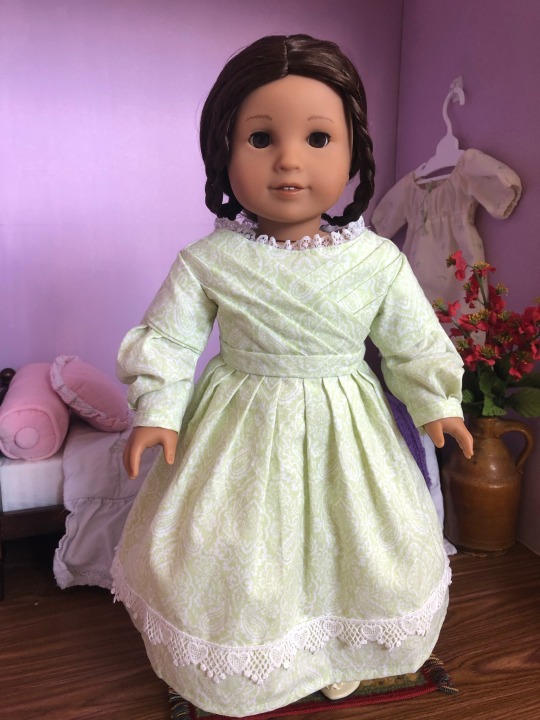
Getting dressed in 1846! (...because I love fashion history)
This dress (from DollClothesByMenay on Etsy!) is quite long for a ten year old, but let’s just say it’s for a formal occasion like a recital or a party, where Cati wants to feel very grown up. The shape of this dress, with its wide neckline and low puffed sleeves, was very popular in the late 1830s and early 1840s. Before this, huge, high-puffed sleeves were all the rage. By the mid 1840s, a straight, tight sleeve and a high neckline were more popular, then the bell-style sleeve became popular in the late 1840s, especially in the USA. (Addy’s original school outfit has this style of sleeves.) Of course, most people don’t throw away their entire wardrobe every time fashion changes, so Cati would still have worn this dress in 1846 and, most likely, would have it altered to fit the newer style, rather than dishing out to have a new dress made. The waistline of this dress is close to the body’s natural waistline; if you look at the transition from 1770s to 1850s, the fashion goes from natural waistline to empire (or just below the bust) and back again really quickly compared to the usual timeline for major silhouette changes in women’s fashion. Whether you like the look of Regency/Jane Austen/Empire era fashion (1790s to early 1830s) or not, it’s so interesting to study how it appeared, became ubiquitous, then completely faded out, all within about a 30 year period. The late 1830s and the 1840s were when the last remnants of Regency fashion transformed into typical early/mid-Victorian fashion.
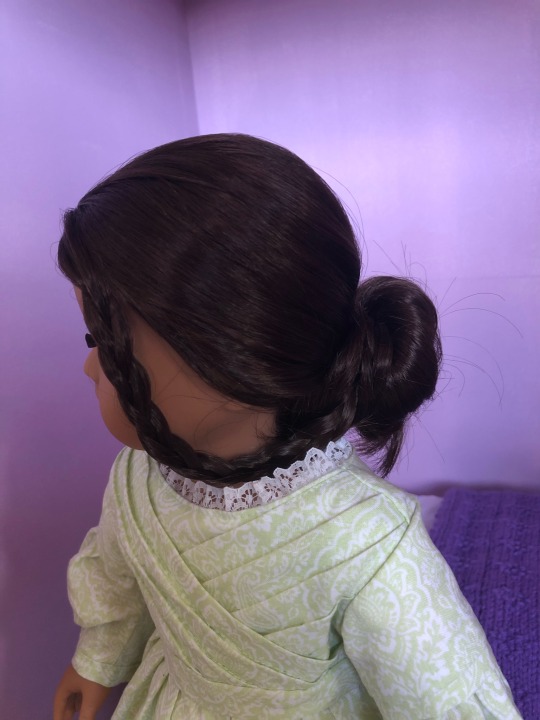
Her hair is in a style popularized by Queen Victoria of England, two braids in the front that loop into a low bun at the back.

This petticoat came with the dress, and supports it beautifully. But to be more historically accurate, Cati would wear several petticoats: first, a simple one, then a corded petticoat (the precursor to the hoop skirt/steel cage crinoline that would be patented in 1856, leading to the massive skirts of the Civil War fashions - before, skirts could only be poofy with layers and layers of petticoats, but weight and heat limited how many could realistically be worn. Funny enough, 18th century panniers were very similar in design to the hoop skirt, as was the 16th century farthingale). She would most likely wear another petticoat on top of the corded petticoat, to conceal any lines or bumps the cording made.
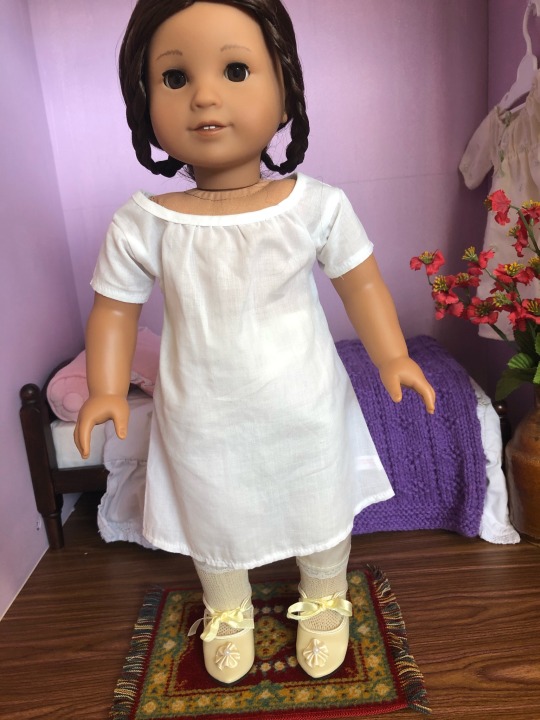
Since Cati is only ten, and her mamá isn’t extremely traditional, she doesn’t wear any stays yet. If she were older, she would wear transitional stays, longer and more structural than the short stays of the empire-waisted Regency fashions, but less shaped than the corsets of the later Victorian era that made a small waistline by enhancing the hips and bust.
So, no stays for Cati, but she does wear a shift (thank you, Felicity). This style of shift or chemise was the standard for centuries (with variations in length, neckline, and sleeve length), but during the latter half of the 19th century, there’s a trend towards increasingly lacy and often sleeveless chemises. By the early 20th century, the standard chemise is sleeveless, but some women wore a pair of combinations, rather than a chemise and split-leg pantalettes/drawers.
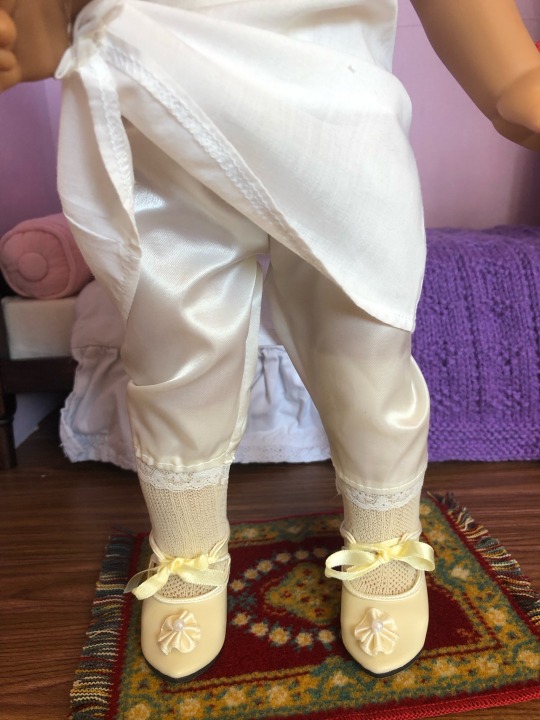
Speaking of pantalettes, here are Cati’s! They came from an old porcelain doll and are a bit snug around her legs. To be more historically accurate, they would be made out of linen or cotton, would reach the tops of her ankles, and would not be joined at the crotch, for easy bathroom access. For most of history, women’s undergarments didn’t include anything between the legs, just skirts. Split-leg pantalettes gained popularity first in children’s clothing, but became adult women’s wear during the Regency period, where skirts were less full and closer to the body.
Under her pantalettes, she wears knit stockings. They come up just past her knees and would be tied in place with a ribbon garter (silk or linen, to grip the stocking) above or below the knee. Her shoes are from CR’s crafts, and mimic extant shoes I’ve seen from this period. I’d like to get her some side-button boots, but haven’t found any I really like yet. As long as she doesn’t do anything more strenuous than music lessons and dancing, she’ll be fine with her dainty slippers.
That’s it! I absolutely love fashion history and how everything changes over time, so I hope some of y’all enjoyed reading this! If anyone else is into this (or not) and wants to add (or correct, I’m not an expert, just a hobbyist) anything, please do!
71 notes
·
View notes
Text
Dating Disney: Tangled
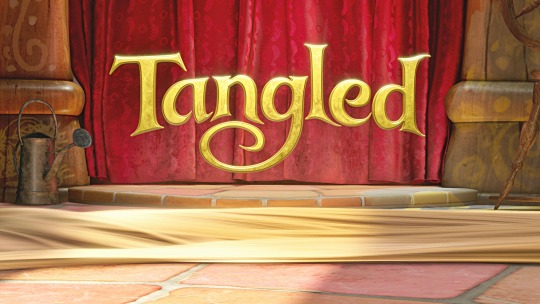
So, let’s just rip this bandage off quickly. This movie is not set in Germany. It simply doesn’t fit. The film is set in France. And before you get your torches and pitchforks, allow me to lay out the evidence.

Persinette
In the movie, Rapunzel’s hair has magical properties. Now the problem with that is, Rapunzel in the German version doesn’t have magic hair. But fret not. For there is a version of her story where she does have magic hair. The French story of Persinette, written in 1698 by Charlotte-Rose de Caumont de La Force. In the tale of Persinette, her hair has the magical power to change shape, length, and density at will, allowing her to turn her hair into a shield or wings. The witch was also named Dame Gothelle, which the Brothers Grimm used for their 1812 version.
Corona

The Kingdom of Corona’s design was inspired by Mont Saint Michel, a commune in Normandy, France. Even the name, Corona, comes from Latin for “Crown”. Latin is a Romance Language, just like French. And what is the French word for Crown? C’est Couronne.

The map above shows where Hazelnuts grow in Europe. If Mother Gothel can find them in three days, then she must live in one of the green areas where the common Hazelnuts grow. Originally, I wondered if she might live in a white area near the green border. However, with all of the evidence pointing at Normandy, France, I was willing to argue that they live in Normandy, but that at the time, there are just no wild hazelnuts in her local vicinity. Just because apples can be grown anywhere doesn’t mean they’re growing every 5 feet apart.
Fashion

Rapunzel’s gown takes on a Jane Austen aesthetic, her novels set during the Regency Era of English history from 1811-1820. This is not a guarantee of a period as Mother Gothel could very well be dressing Rapunzel in out of style dresses she’s collected over the centuries.

Mother Gothel’s attire is a combination of a Rohan gown and a girdle belt. While I could not find an exact era when these fashion elements emerged, I could find this image of a 12th century Norman Noblewoman. While it’s not perfectly hard evidence, it’s sufficient. The look is often labeled as a medieval celtic outfit. Although people often associate the Celts with the British Isles, but there were European mainland Celts in Gallo-Roman France. So whether it’s a 12th century Norman dress from medieval France or a celtic dress from Gaul, she’d still be wearing a very old dress that could be found in Normandy, France.


Rapunzel’s parents seem to be wearing 16th century clothes, with her father really channeling Henry VIII who ruled from 1509-1547. Their clothes are almost as out of date as Mother Gothel’s, but it is possible that they’re wearing “traditional national costumes”, as we only see them during important events. Only in formal portraits and when making public appearances, which might encourage them to pull out very old-fashioned costumes. Otherwise, I have no real excuse for their clothes.
Pop Culture

While in the Snuggly Duckling Tavern, one of the patrons mentions Mozart, who started composing music at the age of three in 1759. Because Rapunzel’s dress is a regency gown from the 1810s, Mozart has already died long before her dress would have been made. Even if the dress is old and out of date, Mozart has already impacted the musical world.
Technology

The fact that Flynn Ryder has mass produced wanted posters, this either means that people are hand-drawing every single poster, or they’re being mass produced with the 1439 invention of the printing press. While the noses change between posters, the sheer quantity suggests mass printing, especially the use of colored dyes in the red text. We also see the queen reading a printed book toward the end, which helps support the time period.
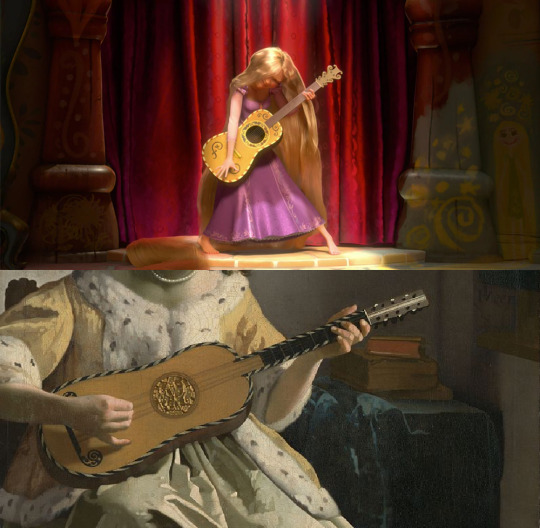
The modern shape of the guitar was invented in 1850. However, since Frozen takes place in 1840, and canonically after Tangled in the timeline, this guitar is an anachronism. However, not entirely. There were other guitars. Just not shaped like this. Pictured below Rapunzel is a Baroque Guitar from a 1672 painting. However, if we choose to ignore the cameo of Rapunzel and Eugene in Frozen, then an 1850 time frame is otherwise perfectly logical for this movie.

Rapunzel can be seen reading Beauty and the Beast (1756), Sleeping Beauty (1812) and The Little Mermaid (1837).
Conclusion
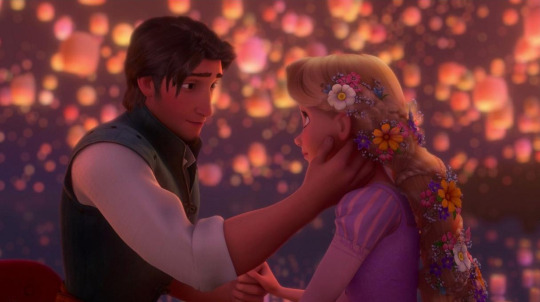
All of the evidence is pointing me to declaring definitively that the movie is set in Normandy, France in the year 1850. Much as I’d like to keep the headcanon that Frozen happens after Tangled, the inclusion of the Guitar says otherwise, and her cameo in Frozen is just that: a cameo. Most crossovers and cameos are second tier canon, and I must go by the evidence in the film. If you simply cannot part with that headcanon, the film could take place in 1837. it’s still 3 years before Frozen, and keeps it plausible for Rapunzel to read The Little Mermaid. Otherwise, I have to go with the primary canon of the film and its stand-alone context to decide its time period. Of course, now we run into the problem of the French Revolution because literally every part of this movie is screaming Normandy. Then again, the king and queen are dressed from the 16th century, Eugene’s jerkin is straight out of the 17th, while his white rolled up sleeves are much more modern. Simply put, this movie just takes place Once Upon a Time, and is a bit of a temporal headache. So, I’m just going to say 1850, Normandy, France. Just block out the people screaming “but the revolution” because this movie is kind of a hot mess when it comes to time periods. Honestly, if you have a better suggestion for how to make sense of this movie’s time period or placement, be my guest, cuz this one is a bit of a headscratcher. We can’t even argue that the French Revolution never happened in the Disneyverse because Napoleon was referenced in Beauty and the Beast. So hit me with your own theorizes because your guess is likely as good as mine on this one. This one may end up getting a second post if I find better evidence.
Setting: Corona (Normandy), France Kingdom: Kingdom of Corona Year: “1850″ Period: Victorian Era Language: French
#dating disney#tangled#rapunzel#normandy#france#mont saint michel#mont st michel#gaul#norman#frozen#little mermaid#sleeping beauty#beauty and the beast#flynn ryder#eugene fitzherbert
827 notes
·
View notes
Text
History of Cufflinks: An illustrated timeline
Introduction
The cuff link has a long and interesting history intertwined with the development of ‘fitted’ clothing – which necessitated the use of buttons. Subsequent development of the ‘worked’ buttonhole, the Industrial Revolution and the evolution of mens’ fashion – culminating in the ‘French cuff’
youtube
Clothing in pre-historic times tended to be functional and related to the hunter-gatherer and later farming lifetyles. Leather, furs and fabrics tended to be wrapped around the body and tied. As these ancient societies evolved, the idea of ‘status’ along with status symbols developed. In terms of clothing fasteners in Ancient Ireland, the elaborate dress fasteners of the Bronze Age comes to mind.
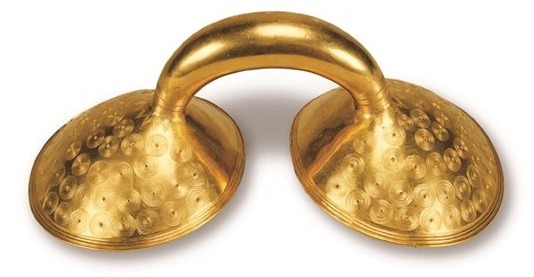
1200’s
Strings pins or belts were used rather than buttons to fasten clothing. It was not until fitted garments became popular in the 13th century that buttons where used as fasteners.

1600’s In the 17th century the decorative lacy cuff of the Renaissance began to give way to more practical styles. At first noblemen began using ribbons to tie their cuffs and the elegance of them was considered a status symbol. By the late 17th century ribbons were replaced by jeweled buttons which were called Sleeve Buttons.
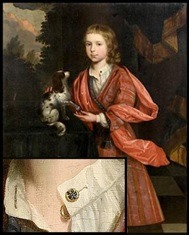
Sleeve Buttons were much more simple than lace They were also much more visually interesting than ribbons Sleeve Buttons became very popular very quickly in the 1600’s
1700’s
By the time of King George (1738-1820) these buttons had become much more ornate. one favourite style was to create miniature paintings on the underside of a piece of glass or quartz. It was still a bauble of the elite classes however, and they were quite expensive to produce due to the material costs involved. This like so many facets of European society changed rapidly with the coming Industrial Revolution.

1800’s
Cufflinks have often been accompanied by matching studs for the front of the shirt, particularly for formal wear from the 19th and 20th centuries.
At the beginning of the reign of Queen Victoria (1837-1901) and towards the end of Britain’s Industrial Revolution the middle class adopted cuff links.
Unable to afford gems they turned to replicas of the real thing. Rhinestones and pastes were used as fake diamonds Pinchbeck a copper and zinc alloy substituted for gold Cut steel marcasite were used for silver A ‘rose’ or flat cut was favoured by late Georgian and Victorian jewelers
1840
The French cuff or double cuff shirt sleeve become a popular fashion accessory. The historical stimulus for the elegant touch in mens’ fashion was the publication of Alexander Dumas “The Three Musketeers”
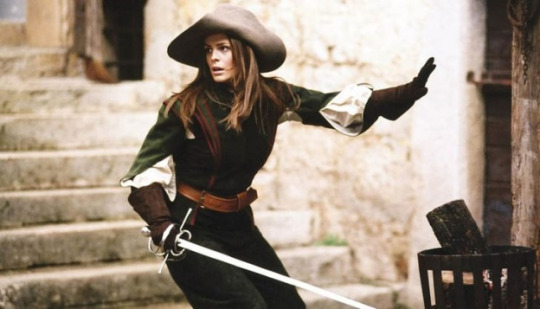
Dumas detailed description of the turned-back sleeves of the men guarding King Louis Xlll inspired European designers to modify the single cuff link-holed shirt which had been a fashion main stay in England.
1882 In 1882 George Krementz invented a machine that was based on a Civil War cartridge shell. It would mass produce one-piece buttons and cuff links very cheaply, which further enabled everyone to enjoy what was once the exclusive domain of the wealthy and privileged.
1900’s
Although the growing middle class liked enameled cuff links during the early Victorian period, it was during the Art Deco period that enamels reached their popularity. Skilled craftmen such as Faberge had perfected the art of using enamels by the end of the 19th century which he then mass produced during the early period of the 20th century.
The Faberage enamel cufflinks are said to have a gem-like brilliance and are highly sought after in auction houses throughout the world.
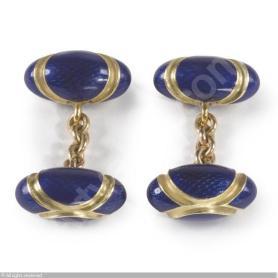
Other leading cuff link designers like Cartier and Tiffanys also began produce cuff links at the turn of the 20th century and were heavily influenced by the Art Nouveau – Art Deco, Cubism period.

The Roaring 20s were probably the height of cuff-link invention. Manufacturers created a variety of devices and designs to do one simple thing: permit a fellow to insert and remove his cufflinks with a minimum of difficulty and a maximum of security.
1924
In 1924, a Mr Boyer, of the Boyer company, created a fastener system made up of a tilting stick between a double stem fixed to the base. Nowadays, this system still remains the most common fastener used.
1950’s
The “stirrup” link enjoyed some popularity in the 1950’s – a curved bar encompassing the cuff from one side to the other.
1970’s In the Seventies, shirts with built-in buttons replace cuff links. Fortunately, the haute couture of famous names kept the style of wearing cuff links which continued to influence many people and kept the tradition alive.
1987 In London salerooms, no provenance is more sought-after than a royal connection. Britain’s royal family rarely parts with jewellery but Edward VIII was one who flew the coop, abdicating in December 1936, to marry the American divorcee Wallis Simpson. She became the Duchess of Windsor and her jewellery was sold at a landmark auction in Geneva in 1987 which raised $50 million. However pieces from the couple’s collection still turn up.
One pair of cuff links sold at auction for $440,000.
They were engraved with the initials ‘E’ and ‘W’
1990’s
The French cuff shirt make a dramatic come back and cuff links become a main stream fashion accessory spanning across all ages. Young people rediscover this accessory.
Paul Smith & Gucci brands start to expand and increase their new cuff link ranges.
A new generation of cuff links was born.
Cuff links, once viewed as a formal jewel becomes an essential accessory for both men and women wanting to express their individuality with style.
2000’s
Today cuff links are worn all over the world by men and women of discriminating taste and style. Whether it’s a classic or a modern design – or even one of the latest in novelty designs – cuff links are something that can be worn and appreciated by anyone who wants to look their best.
2010’s
In 2014, Sotheby’s in London sold a selection of the couple’s jewels and precious objects including a pair of gold and painted enamel cufflinks, featuring portraits of the Duke’s grandparents King Edward VII and Queen Alexandra
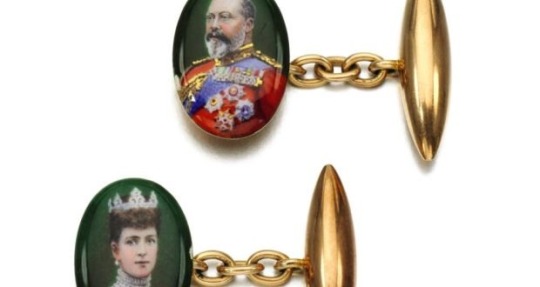
It is often said that a man should never buy his own cufflinks, but that they should always be gifts meant to mark an occasion.
This is a custom that resonates back to the cufflink’s medieval history, to the time when they were made almost exclusively as items meant to commemorate royal affairs.
Thus, these days men have come to recognize the importance of the set passed-down from a grandfather, or given by a best friend at his wedding and might solely rely on such pieces for formal affairs, but are uninhibited about buying their own cufflinks for everyday wear.
View Source: https://numiscufflinks.wordpress.com/2016/03/31/history-of-cufflinks-an-illustrated-timeline/
3 notes
·
View notes
Text
A History of Nursing Uniforms

Prior to the nineteenth Century, nursing was simply one more every day task or obligation of ladies people. Regardless of whether in the home or in the road, ladies have consistently utilized their sustaining manners and intuitive nursing and recuperating capacities to comfort, and sometimes fix, the wiped out and harmed.
tesettür hemşire forması
In the home, ladies tended their own youngsters and went to at the births of different kids. In a period before medical clinics, everybody could profit by some information on emergency treatment and birthing assistance.
In the city, unmarried ladies regularly went around helpless areas where families couldn't bear the cost of a specialist's home call, and performed benefits for nothing for the sake of the nearby wellbeing office or the city.
By the nineteenth Century, these medical caretakers wore a worker's uniform, with white accumulated or grouped cap and a long print dress with a white cover. A few medical attendants started to work for well off families, yet most nursing, as a calling, actually rampaged. Along these lines, nursing was not all around regarded for quite a while. The medical caretakers of the age contributed to some degree to their own bad reputation. Without families, they frequently went through evenings in their lodgings or in the medical clinic storm cellars drinking and partying.
By the 1840s region medical caretakers had gotten more normal, and began to acquire some regard. To some degree prepared medical attendants who worked for the city or neighborhood wellbeing load up wore a more refined and at times more ladylike form of a workers outfit.
Since it was significant for these recently prepared medical caretakers to be perceived in the city, an outside and indoor uniform framework was planned. At the point when the medical caretakers strolled the roads (or rode motorbikes!) in helpless neighborhoods they wore shrouds, covers, and warm caps, and changed into their lovely white "indoor" caps and cover inside.
By 1880, Florence Nightingale's work had transformed nursing into a more legitimate occupation, and she set up a tutoring framework for medical caretakers. They needed to have particular garbs to isolate them from basic undeveloped ladies who went about as helps for the military or in the couple of clinics.
A cap and band framework was conceived to recognize attendants of various position. Contingent upon the school, a medical caretaker would star with groups of pink, blue, or other pastel lace, and advance up to a dark band of strip. A learner didn't have a cap until she spent three months of preparing. Furthermore, and still, after all that, her cap could be repudiated for helpless conduct, such as smoking in the medical clinic. Later on, this position framework would help usher the caps out of uniform stylish. The act of utilizing them for order would in the end be considered barbarous.
When the new century rolled over the uniform began to get much more separated from workers' dress. The bosom and neckline of the dress got more detail (pockets, conservative style top, sharp collars), a chin-wiper covered the middle and accumulated at the midsection with a cover underneath. The texture of the principle dress was strong. This new customized look was conversely with the shapeless cover and dress the normal worker wore.
Caps begin to show impact of sister's coifs, which brought the nursing uniform an acquired look of decency. The two callings converged on occasion in any case, and sister/nurture really had probably the most incredibly planned and incredibly enormous caps nursing could at any point see.
Toward the beginning of the First World War, usefulness turned into the main component in a medical attendant's uniform. War brought untold quantities of setbacks into the attendants' tents, and care must be quick and effective. Cumbersome covers now and then vanished out and out, neatness of appearance passing by the wayside. Skirts abbreviated for better portability, and short or moved up sleeves turned into the standard.
The mix of this requirement for usefulness and the longing to keep a female look to the uniform created after the wars the most natural, and presumably the most alluring and valuable medical caretaker's uniform ever - the one we consider when we envision an attendant.
Between the World Wars and in the short time of thriving during the 1930s, nursing style started to emulate design on the loose. Nursing was a famous calling for females at that point, and magazines and papers were continually calling for newcomers. Ladies had as of late gone into the labor force in any critical number, and for a young lady nursing was an appealing and energizing choice contrasted and, say, composing or sewing. It was a steady work, and what extraordinary garments she had the chance to wear!
During the 1950s caps as positioning identifiers was de-underscored, as it was accepted the framework prompted low resolve among students. The cap was additionally viewed as female, and by done requiring it the medical clinics desire to draw in more male learners. Outfits turned out to be less treated and even less intricate - greater medical clinics implied more patients and quicker speeds and the clothing couldn't keep up. Straightforward collapsed caps and paper caps supplanted the crown-like covers, and more agreeable, less structure fitting plans showed up for the dresses. Everything must be low maintenance.
By the last part of the 1970s the cap had vanished totally in the U.S. The new pattern in nursing design, scours show up on the scene (for men at any rate). Garbs started to look more like customary apparel or sometimes like specialist's jackets. Emergency clinics had started to utilize helps and volunteers, and nursing staff didn't wish to show up in uniform as these undeveloped staff members were needed to do.
Today the separation between medical caretakers, specialists, staff, and so forth is just signified by adornments and unofficial IDs. At most U.S. medical clinics, everybody wears scours consistently to forestall the spread of irresistible sicknesses. Specialists wear coats, medical attendants may now and again wear a warm-up coat, however generally, people, specialists and care staff the same are all in some shade or example of free drawstring jeans and slipover shirts. In Britain, outfits are all the more generally utilized in nursing, specialists actually wear their own garments outside of the OR.
The present cleans are accessible in many styles, shadings and examples. Regardless of whether you are a lady who needs a fitted look, a male medical attendant who lean towards a more obscure hued closet than the one his emergency clinic has to bring to the table, or a medical attendant who needs to light up a patient's day with an unusual example, the huge assets of nursing attire accessible on the web today make certain to offer even the most popular of attendants all the person requires to make the ideal nursing closet.
1 note
·
View note
Text
A History of Nursing Uniforms
Prior to the nineteenth Century, nursing was simply one more every day task or obligation of ladies people. Regardless of whether in the home or in the road, ladies have consistently utilized their sustaining manners and intuitive nursing and recuperating capacities to comfort, and sometimes fix, the wiped out and harmed.
hemşire forması
In the home, ladies tended their own youngsters and went to at the births of different kids. In a period before medical clinics, everybody could profit by some information on emergency treatment and birthing assistance.
In the city, unmarried ladies regularly went around helpless areas where families couldn't bear the cost of a specialist's home call, and performed benefits for nothing for the sake of the nearby wellbeing office or the city.
By the nineteenth Century, these medical caretakers wore a worker's uniform, with white accumulated or grouped cap and a long print dress with a white cover. A few medical attendants started to work for well off families, yet most nursing, as a calling, actually rampaged. Along these lines, nursing was not all around regarded for quite a while. The medical caretakers of the age contributed to some degree to their own bad reputation. Without families, they frequently went through evenings in their lodgings or in the medical clinic storm cellars drinking and partying.
By the 1840s region medical caretakers had gotten more normal, and began to acquire some regard. To some degree prepared medical attendants who worked for the city or neighborhood wellbeing load up wore a more refined and at times more ladylike form of a workers outfit.
Since it was significant for these recently prepared medical caretakers to be perceived in the city, an outside and indoor uniform framework was planned. At the point when the medical caretakers strolled the roads (or rode motorbikes!) in helpless neighborhoods they wore shrouds, covers, and warm caps, and changed into their lovely white "indoor" caps and cover inside.
By 1880, Florence Nightingale's work had transformed nursing into a more legitimate occupation, and she set up a tutoring framework for medical caretakers. They needed to have particular garbs to isolate them from basic undeveloped ladies who went about as helps for the military or in the couple of clinics.
A cap and band framework was conceived to recognize attendants of various position. Contingent upon the school, a medical caretaker would star with groups of pink, blue, or other pastel lace, and advance up to a dark band of strip. A learner didn't have a cap until she spent three months of preparing. Furthermore, and still, after all that, her cap could be repudiated for helpless conduct, such as smoking in the medical clinic. Later on, this position framework would help usher the caps out of uniform stylish. The act of utilizing them for order would in the end be considered barbarous.
When the new century rolled over the uniform began to get much more separated from workers' dress. The bosom and neckline of the dress got more detail (pockets, conservative style top, sharp collars), a chin-wiper covered the middle and accumulated at the midsection with a cover underneath. The texture of the principle dress was strong. This new customized look was conversely with the shapeless cover and dress the normal worker wore.
Caps begin to show impact of sister's coifs, which brought the nursing uniform an acquired look of decency. The two callings converged on occasion in any case, and sister/nurture really had probably the most incredibly planned and incredibly enormous caps nursing could at any point see.
Toward the beginning of the First World War, usefulness turned into the main component in a medical attendant's uniform. War brought untold quantities of setbacks into the attendants' tents, and care must be quick and effective. Cumbersome covers now and then vanished out and out, neatness of appearance passing by the wayside. Skirts abbreviated for better portability, and short or moved up sleeves turned into the standard.
The mix of this requirement for usefulness and the longing to keep a female look to the uniform created after the wars the most natural, and presumably the most alluring and valuable medical caretaker's uniform ever - the one we consider when we envision an attendant.
Between the World Wars and in the short time of thriving during the 1930s, nursing style started to emulate design on the loose. Nursing was a famous calling for females at that point, and magazines and papers were continually calling for newcomers. Ladies had as of late gone into the labor force in any critical number, and for a young lady nursing was an appealing and energizing choice contrasted and, say, composing or sewing. It was a steady work, and what extraordinary garments she had the chance to wear!
During the 1950s caps as positioning identifiers was de-underscored, as it was accepted the framework prompted low resolve among students. The cap was additionally viewed as female, and by done requiring it the medical clinics desire to draw in more male learners. Outfits turned out to be less treated and even less intricate - greater medical clinics implied more patients and quicker speeds and the clothing couldn't keep up. Straightforward collapsed caps and paper caps supplanted the crown-like covers, and more agreeable, less structure fitting plans showed up for the dresses. Everything must be low maintenance.
By the last part of the 1970s the cap had vanished totally in the U.S. The new pattern in nursing design, scours show up on the scene (for men at any rate). Garbs started to look more like customary apparel or sometimes like specialist's jackets. Emergency clinics had started to utilize helps and volunteers, and nursing staff didn't wish to show up in uniform as these undeveloped staff members were needed to do.
Today the separation between medical caretakers, specialists, staff, and so forth is just signified by adornments and unofficial IDs. At most U.S. medical clinics, everybody wears scours consistently to forestall the spread of irresistible sicknesses. Specialists wear coats, medical attendants may now and again wear a warm-up coat, however generally, people, specialists and care staff the same are all in some shade or example of free drawstring jeans and slipover shirts. In Britain, outfits are all the more generally utilized in nursing, specialists actually wear their own garments outside of the OR.
The present cleans are accessible in many styles, shadings and examples. Regardless of whether you are a lady who needs a fitted look, a male medical attendant who lean towards a more obscure hued closet than the one his emergency clinic has to bring to the table, or a medical attendant who needs to light up a patient's day with an unusual example, the huge assets of nursing attire accessible on the web today make certain to offer even the most popular of attendants all the person requires to make the ideal nursing closet.
1 note
·
View note